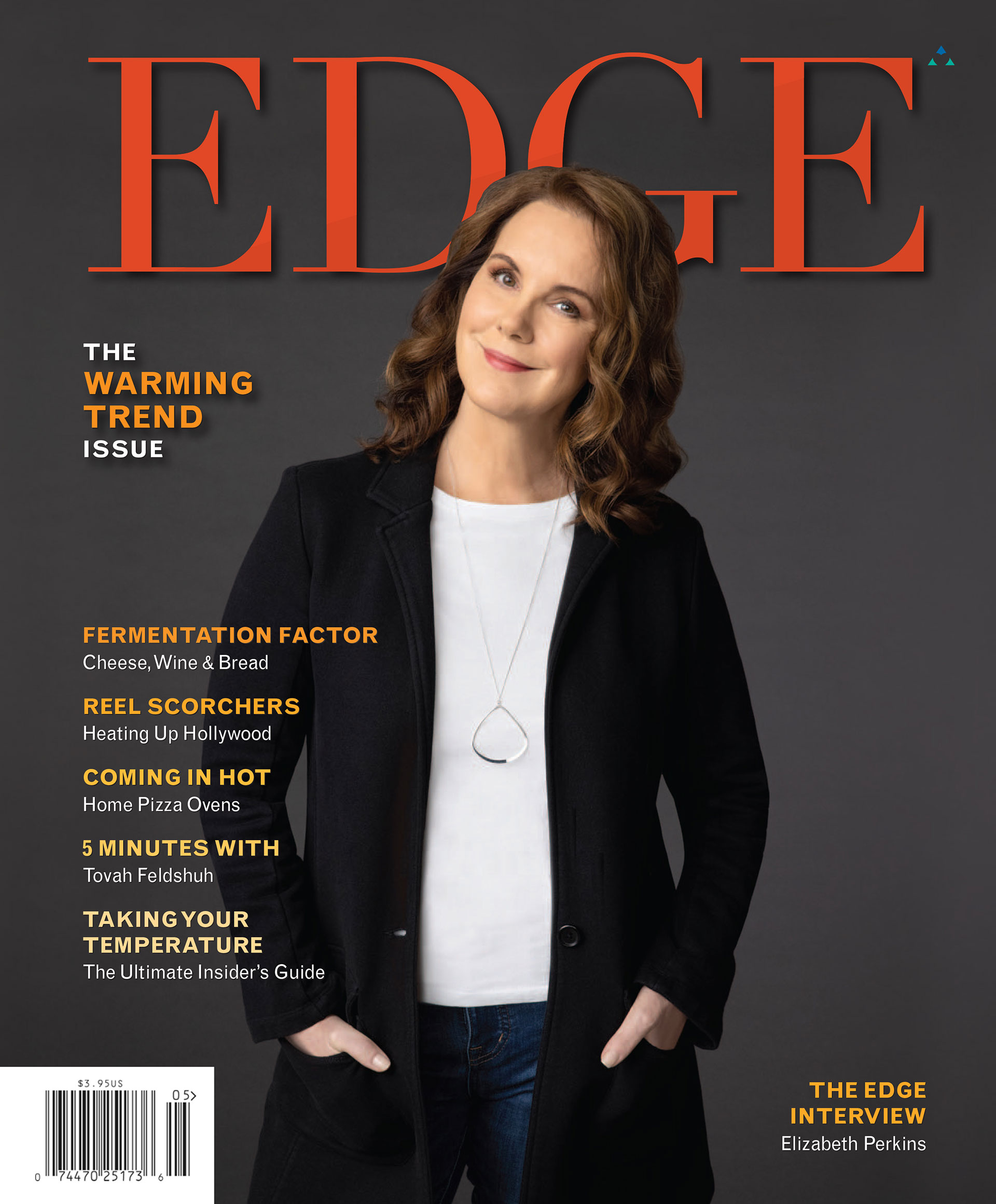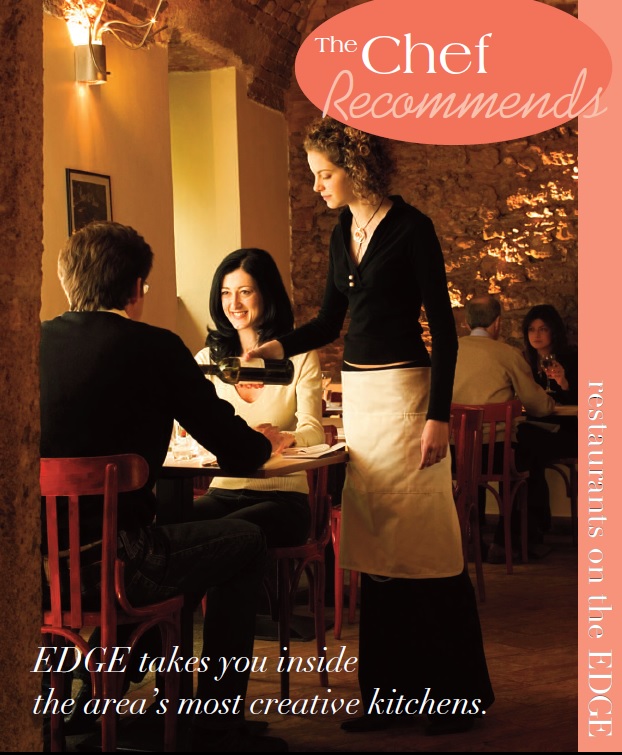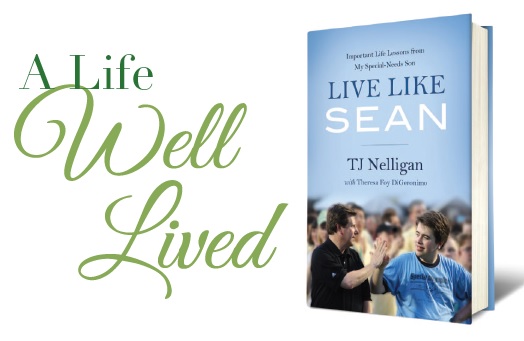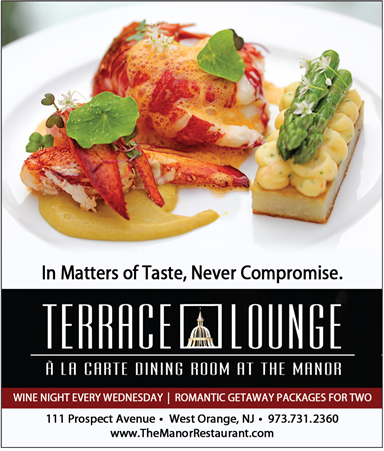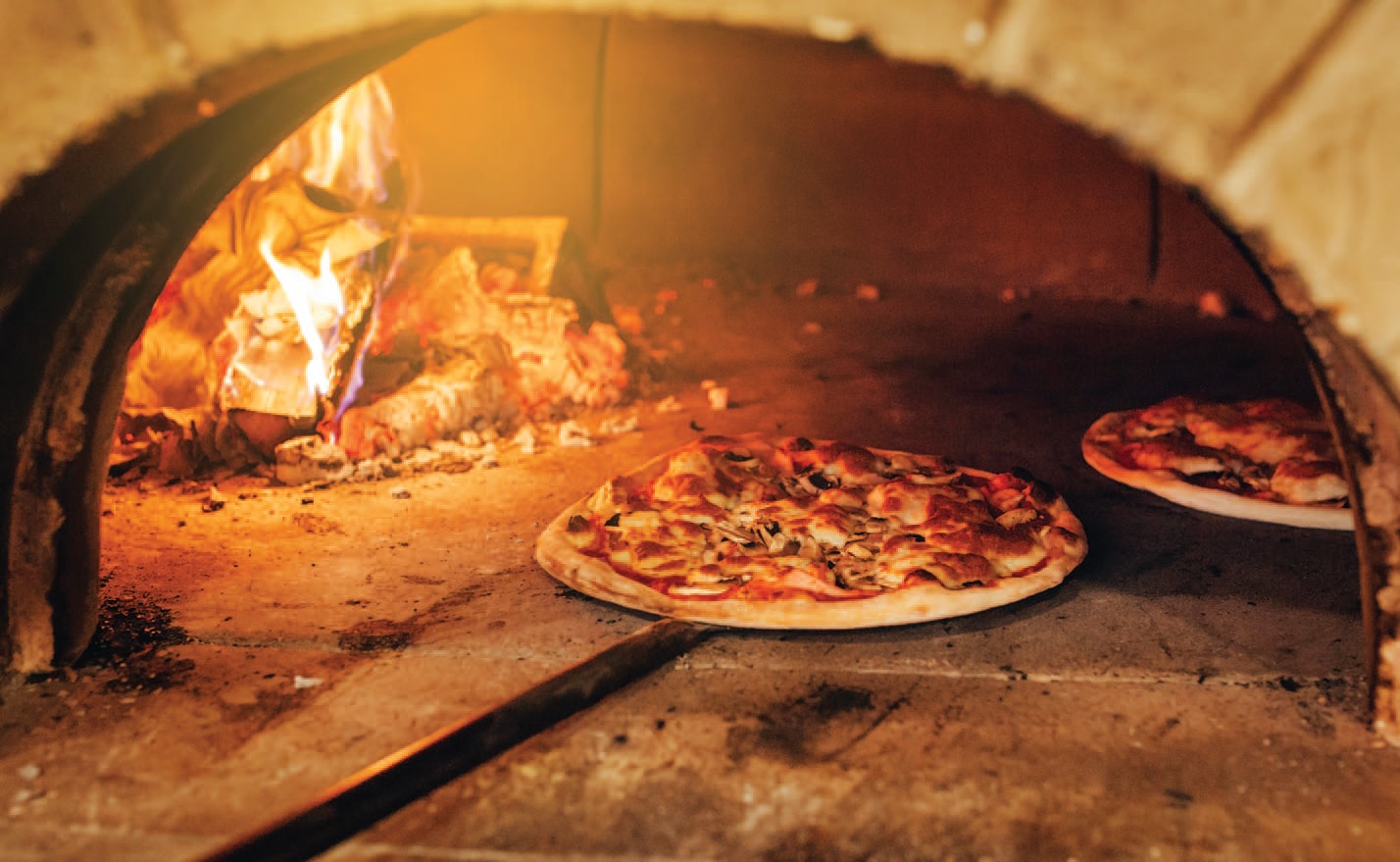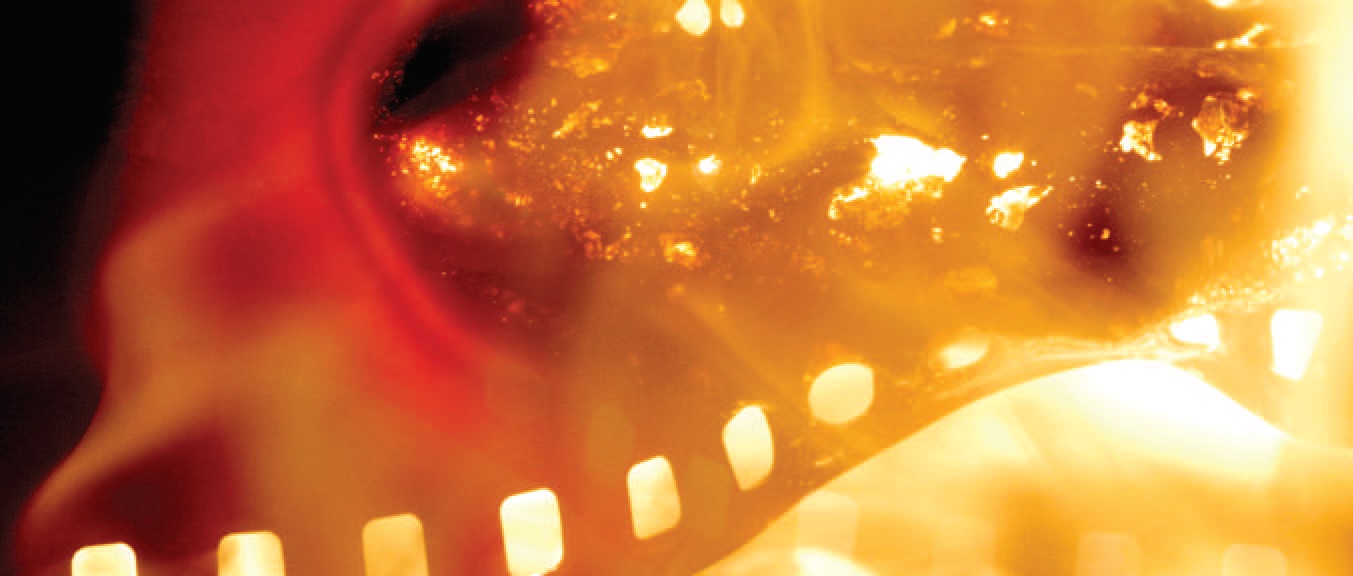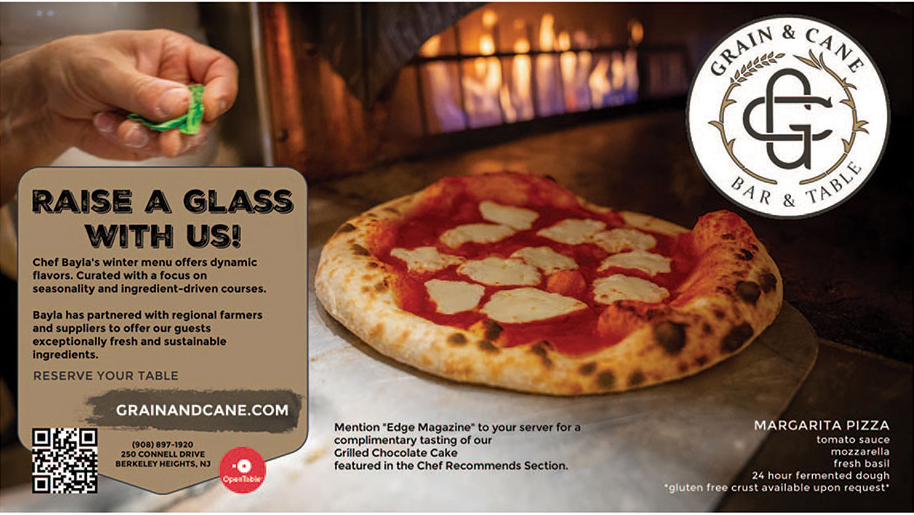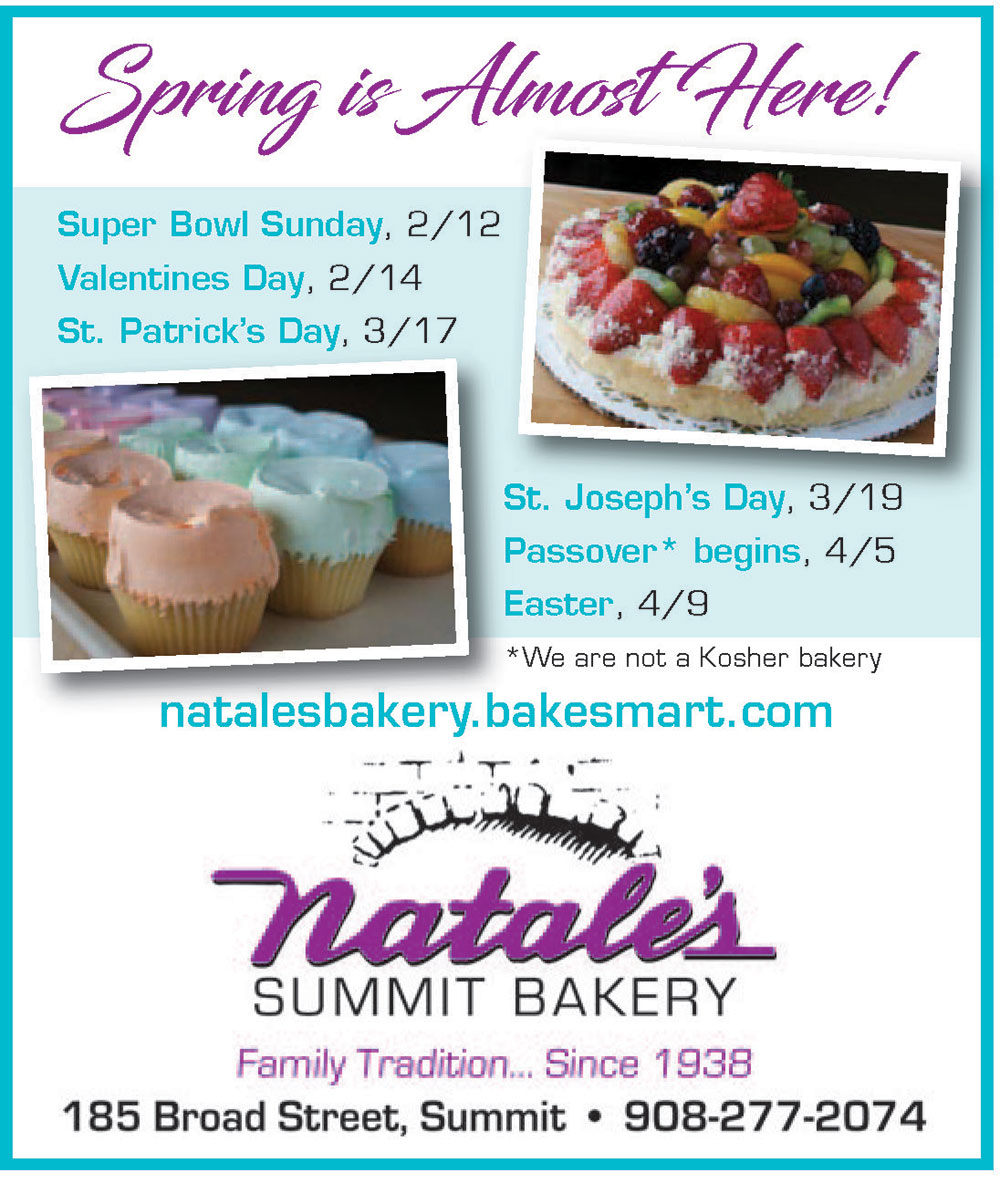EDGE takes you inside the area’s most creative kitchens.
Grain & Cane Bar and Table • Shrimp Tostada
 250 Connell Drive • BERKELEY HEIGHTS
250 Connell Drive • BERKELEY HEIGHTS
(908) 897-1920 • grainandcane.com
Our Shrimp Tostada is a next-level dish crafted with wild-caught gulf shrimp marinated in a lime, tomato water, and pepper marinade. Joined with the vibrant flavors of gazpacho and Peruvian leche de tigre and served with crispy nixtamal tortillas, avocado, watermelon radish, and charred salsa negra.
— Chef Louis Bayla
The Thirsty Turtle • Pork Tenderloin Special
 1-7 South Avenue W. • CRANFORD
1-7 South Avenue W. • CRANFORD
(908) 324-4140 • thirstyturtle.com
Our food specials amaze! I work tirelessly to bring you the best weekly meat, fish and pasta specials. Follow us on social media to get all of the most current updates!
— Chef Rich Crisonio
The Thirsty Turtle • Brownie Sundae
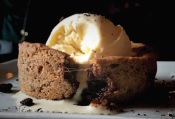 186 Columbia Turnpike • FLORHAM PARK
186 Columbia Turnpike • FLORHAM PARK
(973) 845-6300 • thirstyturtle.com
Check out our awesome desserts brought to you by our committed staff. The variety amazes as does the taste!
— Chef Dennis Peralta
The Famished Frog • Mango Guac
 18 Washington Street • MORRISTOWN
18 Washington Street • MORRISTOWN
(973) 540-9601 • famishedfrog.com
Our refreshing Mango Guac is sure to bring the taste of the Southwest to Morristown.
— Chef Ken Raymond
Arirang Hibachi Steakhouse • Pork Belly Bao Buns
 1230 Route 22 West • MOUNTAINSIDE
1230 Route 22 West • MOUNTAINSIDE
(908) 518-9733 • partyonthegrill.com
Tender pork belly, hoisin sauce and pickled cucumber served on a Chinese bun.
LongHorn Steakhouse • Outlaw Ribeye
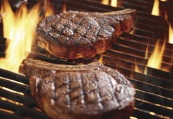 272 Route 22 West • SPRINGFIELD
272 Route 22 West • SPRINGFIELD
(973) 315-2049 • longhornsteakhouse.com
Join us for our “speedy affordable lunches” or dinner. We suggest you try our fresh, never frozen, 18 oz. bone-in Outlaw Ribeye—featuring juicy marbling that is perfectly seasoned and fire-grilled by our expert Grill Masters. Make sure to also try our amazing chicken and seafood dishes, as well.
— Anthony Levy, Managing Partner
Ursino Steakhouse & Tavern • House Carved 16oz New York Strip Steak
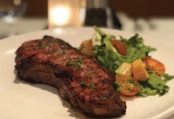 1075 Morris Avenue • UNION
1075 Morris Avenue • UNION
(908) 977-9699 • ursinosteakhouse.com
Be it a sizzling filet in the steakhouse or our signature burger in the tavern upstairs, Ursino is sure to please the most selective palates. Our carefully composed menus feature fresh, seasonal ingredients and reflect the passion we put into each and every meal we serve.
Support Our Chefs!
The restaurants featured in this section are open for business and are serving customers in
compliance with state regulations. Many have created special menus ideal for take-out,
delivery or socially distant dining, so we encourage you to visit them online.
Do you have a story about a favorite restaurant going the extra mile during the pandemic?
Post it on our Facebook page and we’ll make sure to share it with our readers!

Richard A. Botto • Niatross • Oil • 36” x 48”
Father and daughter artists have existed for centuries of art history, although daughters weren’t recognized back then. As a result of groups such as the feminist Guerilla Girls, the daughters eventually received credit for their own masterful work. Not the case with Richard A. Botto and Lisa Botto Lee, who fit the description by an unknown author: “Not only a father is an example for a daughter, but a daughter is a great inspiration for a father.” Richard and Lisa are both classically trained and are representational artists who embrace narrative realism. What a great and eternal bond!

Lisa Botto Lee • Last of the Breed • Oil • 30” x 48”
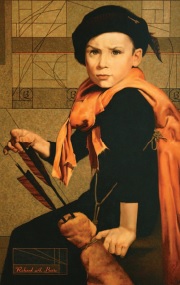
Richard A. Botto • Dynamic Symmetry Oil • 30” x 18”

Richard A. Botto • Dynamic Symmetry II Oil • 23” x 19”

Lisa Botto Lee • Beyond the Window • Oil • 30” x 24”
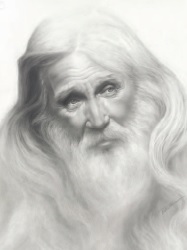
Lisa Botto Lee • A Wrinkle in Time Graphite • 30” x 22”

Richard A. Botto • Releasing Lindy • Oil • 24” x 36”

Richard A. Botto • Blind Fury • Oil • 24” x 30”

Lisa Botto Lee • Highlander • Oil • 12” x 12”

Lisa Botto Lee • Ewe & Me • Oil • 28” x 22”

Richard A. Botto • No Nay Never • Oil • 24” x 30”

Lisa Botto Lee • Walk Easy • Oil • 60” x 40”
About the Artists
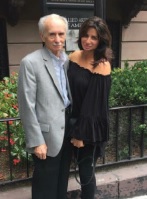 My father and I have never exhibited together,” says Lisa Botto Lee, a New Jersey native now of Weston, FL. “We’re so excited to see our work side by side.” She and her father, Richard A. Botto, of Ridgefield Park, have many accolades. Both do portraits, nature, wildlife, and figurative work. Richard specializes in equine paintings. Says Richard, “It’s been a privilege to paint some of the greatest harness champions,” among them are Moni Maker and Marion Marauder, a Triple Crown winner. A graduate of Pratt Institute, Richard studied at the Art Students League, his work has been exhibited in the National Academy of Design, NY, The Trenton Museum, Bergen Museum of Arts & Sciences, NJ, the Butler Institute of American Art, OH, The Harness Racing Museum & Hall of Fame and other prestigious venues.
My father and I have never exhibited together,” says Lisa Botto Lee, a New Jersey native now of Weston, FL. “We’re so excited to see our work side by side.” She and her father, Richard A. Botto, of Ridgefield Park, have many accolades. Both do portraits, nature, wildlife, and figurative work. Richard specializes in equine paintings. Says Richard, “It’s been a privilege to paint some of the greatest harness champions,” among them are Moni Maker and Marion Marauder, a Triple Crown winner. A graduate of Pratt Institute, Richard studied at the Art Students League, his work has been exhibited in the National Academy of Design, NY, The Trenton Museum, Bergen Museum of Arts & Sciences, NJ, the Butler Institute of American Art, OH, The Harness Racing Museum & Hall of Fame and other prestigious venues.
Lisa, a fifth-generation of muralists of Northern Italy, won awards in regional, national, and worldwide competitions and has exhibited in the Versace Mansion, Miami, Salmagundi Club, NY, The National Arts Club and The Art Center Renewal (ARC) and other venues. And speaking of family, Lisa’s mother, Marguerite, is a watercolorist and former art teacher. She and Richard traveled throughout the US, Canada, and Europe to photograph horses. The Botto family continues a mighty line of masters.
—Tova Navarra
Your new memoir, Lilyville, explores the evolution of your relationship with your mother, Lily, interwoven with the evolution of your acting career. It was not always an easy relationship, was it?
No. My mother was born on a table in the Bronx in 1911 and believed that you shouldn’t praise your children too much, lest they grow too proud and evil should strike them down. This wasn’t just a Jewish tradition, it was a peasant tradition, I think from her family’s roots in Eastern Europe. Training your child, correcting your child, fixing, preserving and protecting your child was the priority—and it was a priority I absolutely did not understand or appreciate, in the sense that I could not equate that with love. By contrast, my father had unbridled,  unconditional love for his children. My mother and I struggled. It was tough. When I turned 18, I asked her if she loved me—it was right out of Fiddler On the Roof—and she said, “Who sat in the station wagon while you were at your piano lessons? Who took you to Hebrew school? Who takes you to the voice lessons you insist on having? Who carts you all over the place to fulfill your desires? That’s me.”
unconditional love for his children. My mother and I struggled. It was tough. When I turned 18, I asked her if she loved me—it was right out of Fiddler On the Roof—and she said, “Who sat in the station wagon while you were at your piano lessons? Who took you to Hebrew school? Who takes you to the voice lessons you insist on having? Who carts you all over the place to fulfill your desires? That’s me.”
Did she approve of your career choice?
I did not have her approval. There was no support. She was very transparent in not wanting me to go into theater. My older brother David had gone into theater so that was one child “down the tubes,” and now her second child…what did I do to have these two kids in the arts? Well, in my case, I had to construct this whole fantasy life just to feel good!
Did that change with your success on Broadway and all your awards?
No. The first confluence of our values was the day I married. She said, “You can do anything you want now…you married a Harvard lawyer!” She had married a Harvard lawyer, so she could finally breathe a sigh of relief. However, as our lives progressed, and I became a mother, my mother and I had more and more in common. She lived long enough for us to solve all of our problems.
What changed?
Part of the reason was that I wanted to. I didn’t sit there waiting for fate to come my way. When I turned 40, she asked, “How much longer are you going to blame me?” I said, “Not another minute.” Our journey was so enormous that, rather than writing a memoir about my life, I thought it would be more interesting to relate it to this woman who lived 103 years, to give my readers, my audience, a rich overview of having a mother who was born before women’s suffrage and who lived through the Spanish Flu, Roaring Twenties, the Great Depression—during which she put herself through NYU—and World War II, when her husband was drafted at 32. I loved my mother. She was hilarious. On her tombstone it says Mother Grandmother Matriarch Comedian.
Editor’s Note: This interview was conducted while Tovah was on a six-mile bike ride around Central Park. For another five minutes (and then some) on Lilyville and the mothers and daughters she’s played, visit edgemagonline.com. Lilyville is published by Hachette Books.
Our favorite products for turning up & turning down the heat.

OCCOPA
Portable Hand Warmer • $30
A rechargeable and USB-friendly solution for cold hands, arthritis and Raynaud’s sufferers.
 LOOFTLIGHTER
LOOFTLIGHTER
Electric Fire Starter • $75
Starts charcoal glowing in under a minute and works in fireplaces and pizza ovens.
 LG
LG
LP1419IVSM Portable AC • $650 Cools and dehumidifies a big room efficiently when a window unit isn’t quite right.
 SALOMON
SALOMON
XA Running Cap • $20 Features a moisture-wicking headband and extra venting for hot summer days.
 MARMOT
MARMOT
Midgard 4-Season Tent • $350
A popular two-person tent that performs equally well in summer and winter.
 WEATHERBEETA
WEATHERBEETA
300D Deluxe Parka • $50
A fetching reflective parka that’s warm, waterproof and breathable.
 DARN TOUGH
DARN TOUGH
Hiker Micro Socks • $25
Cool in summer, warm in winter, durable, high-performing and guaranteed for life.
Exercise your right to take a culinary stay-cation this summer.
Overseas travel may continue to be a challenge in the rush to get everyone vaccinated. However, you can still enjoy a taste of a country’s cultural identity through its national dish. Whether picking from a dine-in or takeout menu, or shopping in one of New Jersey’s now-ubiquitous international markets, feel perfectly free to cobble together your own culinary itinerary. We’ve picked out six of the spiciest signature dishes—three you can find easily, and three that may just turn out to be your gateway to adventure.
 Kimchi
Kimchi
The “five elements” theory of Korean culture is embodied in kimchi, fermented cabbage that combines sweet, sour, salty, bitter and knock-your-socks-off spicy. It’s an ancient staple that has crossed over into American kitchens and restaurants in many creative forms—in main dishes, stews, side dishes and condiments—and its availability is no longer limited to Asian markets. In South Korea, kimchi is served with almost every meal, including breakfast.
 Mole
Mole
Mole (pronounced Mo-lay) is Mexico’s curry, kind of—there are countless versions, with limitless complexity. Mole pablano is the most common served in the U.S. What they all have in common is bittersweet dark chocolate, which is flavored with chilies, garlic, onions and a dozen or more spices. The caffeine in the chocolate releases endorphins, while the capsicum in the peppers provides a shot of adrenaline. It’s a rush. Mole is often part of the most expensive dishes on Mexican restaurant menus for a reason. Expect spicy not sweet, if you order it and be aware that it often contains ground nuts.
 Pad Thai
Pad Thai
The signature dish of Thailand has rocketed to prominence over the last 25 years and now ranks among the most popular foods on the planet. And yet pad Thai is less than 100 years old, the result of a competition in Siam during the 1930s to create a national dish. It’s made with stir-fried rice noodles, fish sauce, roasted peanuts, tamarind, scrambled eggs and just about any combination of meat and vegetables. Simple as pad Thai sounds, in the U.S., every restaurant seems to have its own slightly different take—so if you like spicy, it’s always helpful to let your server know. The translation of pad, if you’re interested, is “fried” (most people think its “noodles”).
 Ema Datshi
Ema Datshi
So on your next visit to your friendly neighborhood Bhutanese bistro, make sure to order Bhutan’s signature dish, an intriguing combination of tear-inducing chilies and soft cheese in a tomato-and-onion stew. Actually, there are quite a number of Bhutanese immigrants who have made their home in the U.S.—between 100,000 and 200,000, in fact—and many have settled in the northeast, from Pennsylvania up through Vermont and New Hampshire. Many are refugees who traveled through Nepal to get here, and are thus classified as Nepalese. Your best bet to locate this dish is in a Himalayan restaurant, of which there are more than a few in the tri-state area.
 Machboos
Machboos
The Kingdom of Bahrain achieved independence in 1971, so if you don’t know exactly where it is, you may be giving away your age. For the record, Bahrain is an island nation in the Persian Gulf, connected to the Arabian Peninsula by a 25-mile bridge. Its national dish—often consumed with family members on Fridays—Machboos, is a spicy chicken meal strongly influenced by Persian and Indian cuisine. It is popular throughout the Middle East and is actually fairly easy to make at home. In addition to chilies, classic ingredients include ginger, coriander, cardamom, cinnamon and nutmeg. So yeah, it’s super-aromatic.
 Pepperpot
Pepperpot
If you’re partial to Caribbean peppers, the national stew of Guyana is one you ought to try. Its signature ingredient is cassareep, a dark, syrupy extract from the cassava root that probably dates back to Guyana’s indigenous inhabitants, who used it as a preservative. The meat is whatever’s available, but typically beef, goat or oxtail. Roughly a quarter-million Guyanese-Americans live in the US, with most residing in New York’s  outer boroughs (as well as northern New Jersey), so finding a good pepperpot isn’t as hard as you might think.
outer boroughs (as well as northern New Jersey), so finding a good pepperpot isn’t as hard as you might think.
In Live Like Sean, a New Jersey father reflects on lessons learned from his special-needs son.
Father’s Day 2019 was a difficult day for the Nelligan family. Sean Nelligan passed away at the age of 29, leaving his parents, TJ and Maggie, and sisters Meghan and Moira with a profound void they would struggle to fill. Sean was a special-needs child whose intellectual and developmental issues, the Nelligans were told, would keep him from living a meaningful life. As it turned out, Sean packed far more meaning into his 29 years than most of us do in a lifetime.
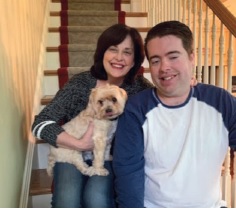 While composing his son’s eulogy—a collection of heart-warming vignettes he planned to recount at Sean’s memorial service—TJ Nelligan realized that the young man who was unable to read or write had created a legacy of life lessons that he wanted to share. On the day of Sean’s funeral, Nelligan told a room packed with hundreds of friends and loved ones, “Live like Sean every day and you will make the lives of others so much better…and it will make you feel better, also.”
While composing his son’s eulogy—a collection of heart-warming vignettes he planned to recount at Sean’s memorial service—TJ Nelligan realized that the young man who was unable to read or write had created a legacy of life lessons that he wanted to share. On the day of Sean’s funeral, Nelligan told a room packed with hundreds of friends and loved ones, “Live like Sean every day and you will make the lives of others so much better…and it will make you feel better, also.”
After the service, Steve Adubato, a family friend, suggested to TJ that he consider extending this message to a wider audience by writing a book. Adubato introduced him to Theresa DiGeronimo and together they produced Live Like Sean, published in 2021 by Greenleaf Book Group Press ($19.95).
“When Sean was born we took home what we thought was a perfectly healthy boy,” Nelligan recalls. “Over the first two months he started having leg spasms, which later were determined to be seizures. Over the next two years his development was delayed—it took him a long time to walk, a long time to talk—but I was in denial. I was like, Everything will be fine. A friend connected me to 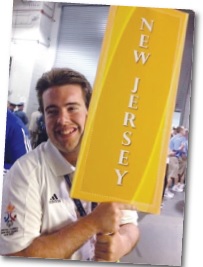 the foremost child neurologist in the world and we went to his office. He took Sean for about an hour and came back and basically told us that our son had intellectual disabilities, that he would never live a normal life…and probably never fit in with normal mainstream society…and that, as he got older, these disabilities would become more pronounced. It was like getting punched in the face, and like Mike Tyson used to say, everyone’s got a plan until they get punched in the face.”
the foremost child neurologist in the world and we went to his office. He took Sean for about an hour and came back and basically told us that our son had intellectual disabilities, that he would never live a normal life…and probably never fit in with normal mainstream society…and that, as he got older, these disabilities would become more pronounced. It was like getting punched in the face, and like Mike Tyson used to say, everyone’s got a plan until they get punched in the face.”
Years of physical therapy and speech therapy followed. The Nelligans learned how to deal with the seemingly endless private and public issues involved in raising a special-needs child. Then, when Sean hit his teen years, something marvelous happened.
“Suddenly he became this amazing personality,” says Nelligan. “He was funny. He was kind. He would laugh at everything. He loved life. He loved sports and, because I worked in college sports marketing, we went to tons of sporting events over the years. I bought Sean an iPad and he memorized all of the college sports logos, which I was amazed by.”
One day, while father and son were watching ESPN and the scores were scrolling across the screen, Sean began telling his dad who was winning each game. What’s going on here, TJ wondered—how could he possibly know all these things? At a Giants game, Sean said, “Giants are winning 7–0…if they score another touchdown it’ll be 14–0.”
“I was like, How does he know that?” Nelligan remembers. “I asked him what seven plus seven was, and he just looked away. That’s what he’d do if he didn’t know the answer to something. He was doing what we called ‘sports math.’”
Special Olympics programs provided Sean with a physical outlet for his interest in sports, and also enabled him to build friendships and camaraderie with his teammates—and he became quite good at basketball. Nelligan was all-in on Special Olympics and ended up spearheading the effort to bring the Special Olympics USA Games to New Jersey in 2014, serving as its Chairman and CEO.
Live Like Sean is, first and foremost, a heartwarming and inspirational story about a life well lived in the face of daunting challenges. It also doubles as an invaluable handbook for families of special-needs children. Its reach, however, extends beyond what one might assume is “baked-in” readership to engage and inform a much wider audience. Hence the book’s title. The authors build their story on a framework that devotes each chapter to a simple, clear life lesson that Nelligan absorbed from his son: Be Present, Be Friendly, Be an Inspiration, etc. Words to live by, for certain.
 “One of the most important things Sean taught me—and this was difficult for a guy with a Type-A personality—was to have gratitude,” says Nelligan. “He couldn’t spell gratitude…but he lived it every single day.” Not surprisingly, Chapter One in Live Like Sean is entitled Be Grateful.
“One of the most important things Sean taught me—and this was difficult for a guy with a Type-A personality—was to have gratitude,” says Nelligan. “He couldn’t spell gratitude…but he lived it every single day.” Not surprisingly, Chapter One in Live Like Sean is entitled Be Grateful.
Like so many families of special-needs kids, the Nelligans started their journey believing they had to protect Sean and teach him about life. By the time he reached his twenties, they realized he had taught them far more about life than they could ever teach him.
“In the beginning of that journey,” says TJ Nelligan, “you wonder How are we going to live like this? Now that he’s not here…I wonder How can we live without him?”
Editor’s Note: Longtime Montville resident TJ Nelligan is a marketing and sales executive who has worked as a tireless advocate for individuals with intellectual and developmental disabilities. He founded (and later sold) Nelligan Sports Marketing and served on the board of New Jersey Special Olympics for more than a decade. He also raised millions of dollars for the Special Olympics New Jersey Sports Complex in Lawrenceville. For more information on Live Like Sean visit tjnelligan.com.
There is simply no explaining some of history’s weirdest trends.
Imitation is the sincerest form of flattery. Until the imitators suddenly realize how stupid they are. Our cultural history is littered with absurd trends that enjoyed a shining moment of mass fascination, only to wind up as objects of ridicule. Most have been mercifully laid to rest for all time, yet others inexplicably continue to rise from the crypt, rediscovered or reinvented by a new generation. The following trends have yet to return—thankfully, but perhaps not permanently. Just remember, as you read about them and chuckle, there is no telling what can happen when a few million of us decide together that some thing is the next big thing.
Color Me Dreadful
The 1970s may be remembered for outlandish fashion and funky, eye-popping design, but that is more a product of retro TV commercials and revisionist history than reality. Clothing, carpeting, drapes, furniture, countertops, cabinets, appliances and even cars were drenched in drab, dreadful burnt oranges, dark walnuts and two of the ugliest colors ever yet realized: Avocado Green and Harvest Gold.
Those who claim there is “no accounting for taste“ might be surprised that a good deal of accountability for these nauseating hues lies right here in New Jersey. For more than a half-century, a select committee of 10 people, whose identities have never been disclosed to the public, has met twice a year with executives of Pantone, a company based in the Bergen County town of Carlstadt. Founded in 1963 by Lawrence Herbert—who created a system for identifying, matching, and communicating colors for consistency across all design industries—Pantone has a mind-numbing 1,925 colors in its current catalog. Its Color Institute studies how “color influences human thought processes, emotions and physical reactions, furthering its commitment to providing professionals with a greater understanding of color and to help them utilize color more effectively.” Avocado and Harvest were Pantone creations; their sister colors included Navajo White and Selective Yellow, which sound vaguely racist today.
 I was a pre-teen in the early ’70s, and I swear that almost everything that came in more than one color also came in Avocado Green and Harvest Gold. My objection to these colors is perhaps more visceral than it ought to be. One weekend in 1972, my parents rented an enormous Avocado Green Plymouth Fury station wagon (with matching interior) while waiting for our little white Audi wagon to be repaired for the umpteenth time. Halfway through the 100-mile journey to our summer house in the Catskills, the noxious smell of the Naugahyde, combined with the nauseating color scheme, literally made me vomit. It was the last time that I remember ever being carsick. Now you won’t find a single Avocado Green object in my home. Well, except for actual avocados, which I love. Go figure.
I was a pre-teen in the early ’70s, and I swear that almost everything that came in more than one color also came in Avocado Green and Harvest Gold. My objection to these colors is perhaps more visceral than it ought to be. One weekend in 1972, my parents rented an enormous Avocado Green Plymouth Fury station wagon (with matching interior) while waiting for our little white Audi wagon to be repaired for the umpteenth time. Halfway through the 100-mile journey to our summer house in the Catskills, the noxious smell of the Naugahyde, combined with the nauseating color scheme, literally made me vomit. It was the last time that I remember ever being carsick. Now you won’t find a single Avocado Green object in my home. Well, except for actual avocados, which I love. Go figure.
Beanie Weenies
We all grew up with Jack and the Beanstalk, the tale of a boy who trades his family cow for a handful of magic beans. In most versions, Jack comes out on top of this transaction. This was not the case for the countless millions who exchanged fists full of cash for a different type of bean-based promise. This story begins in 1986, when Ty Warner, the top salesman at Dakin & Co.—the world’s largest maker of stuffed toys—suggested to the higher-ups that using plastic “beans” as filler instead of stiff cotton would make the toys more flexible and posable. He was thanked by being fired.
 Warner pressed on with his idea and, in 1993, founded Ty Inc. to produce Beanie Babies. Warner saw the product itself as secondary to the marketing. He priced Beanie Babies at an affordable $5, but sold them only in limited quantities to small specialty shops and toy stores rather than big-box chains—to raise desirability by creating scarcity. Consumers could never find an entire collection of Beanies at one single store.
Warner pressed on with his idea and, in 1993, founded Ty Inc. to produce Beanie Babies. Warner saw the product itself as secondary to the marketing. He priced Beanie Babies at an affordable $5, but sold them only in limited quantities to small specialty shops and toy stores rather than big-box chains—to raise desirability by creating scarcity. Consumers could never find an entire collection of Beanies at one single store.
In 1995, Warner started “retiring” certain Beanie Babies, triggering explosive interest in the secondary collector market. Prices for these originals surged past $20. Meanwhile, Warner’s overseas factories were pumping out boatloads of non-retired ones. By 1998, Ty Inc. was making more than $1 billion in profits.
By the turn of the 20th century, rabid collectors and misguided investors, uninterested in trivialities like supply and demand, had become obsessed with collecting Beanies as an investment. The arrival of eBay around this time only fueled their madness; some of the rarest were selling online for as much as five figures. In 1999, Warner officially “retired” several more Beanie Babies, but this time there wasn’t any market response—no notable increase in value or spike in demand. It was the beginning of the end.
Collectors panicked and flooded eBay with tens of thousands of them and their value blew away like sand in the Sahara. In desperation, Warner ordered all production halted by the end of the year, but his announcement did nothing to stop the big bust. By the early 2000s, most Beanies were worth between 1 and 5 percent of their former prices and wound up in truck-stop claw machines. Don’t be too quick to shed a tear for Warner, however. In 2020, the 76-year-old ranked 359th on the Forbes 400 list of the richest people in America, with a net worth of $2.3 billion.
Record Breakers
Half a century ago, before the internet, cable and even VCRs, the big three national broadcast television networks (CBS, NBC and ABC) produced pretty much all there was to watch. When they struck gold with a hit TV series, they often attempted to leverage their stars’ popularity by ushering them into the recording studio—whether or not they had even a shred of singing talent. Not to worry, they could always cut a spoken record. With very few exceptions, the result was a hilariously awful novelty single or, worse, a full-blown album. And, of course, they sold like hotcakes. These ill-conceived celebrity records are collectible kitsch today, but back in the 1960s they could be found in almost every home in America. These celebrity recordings are a few of my personal favorites. All can be found online:
A 1965 episode of The Addams Family featured Ted Cassidy (aka Lurch) as an overnight teen idol pop star. Cassidy teamed up with Gary Paxton—producer of “Alley-Oop” and “Monster Mash”—on a Motown-style dance single entitled “(Do) The Lurch.” Cassidy actually performed it on the popular variety shows Shivaree! and Shindig! for Halloween.
Sebastian Cabot, who is best remembered today for his role as Brian Keith’s butler, Mr. French, on Family Affair—and as the voice of Bagheera in Disney’s The Jungle Book—recorded a full album of poetic interpretations of Bob Dylan songs in 1967. Sebastian Cabot, Actor featured a full orchestra, and included “Like a Rolling Stone,” “Blowin’ In the Wind” and “It Ain’t Me, Babe.”
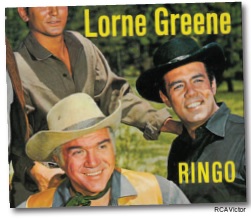 Lorne Greene, who played frontier patriarch Ben Cartwright on Bonanza, had a #1 hit on the US Billboard charts on December 5, 1964 with “Ringo”— a 45 from his album Welcome to the Ponderosa. Singing satirist Allan Sherman re-recorded the song as “The Ballad of Ringo Starr.”
Lorne Greene, who played frontier patriarch Ben Cartwright on Bonanza, had a #1 hit on the US Billboard charts on December 5, 1964 with “Ringo”— a 45 from his album Welcome to the Ponderosa. Singing satirist Allan Sherman re-recorded the song as “The Ballad of Ringo Starr.”
In 1966, when Batman was the top-rated TV show in the US and “Bat-mania” was sweeping the country, MGM Records signed Burt Ward (aka Robin) to release “Boy Wonder, I Love You” and “Teenage Bill of Rights”—written and arranged by none other than Frank Zappa and performed by The Mothers of Invention. “It was one of the weirdest projects I’ve ever been involved in,” Zappa later reflected.
On the subject of weird, among the most famous/ infamous celebrity albums was a 1968 LP entitled The Transformed Man by TV’s Captain Kirk, William Shatner. It included a disturbing version of Bob Dylan’s “Mr. Tambourine Man” as well as dramatic readings of Shakespeare. George Clooney once included The Transformed Man in his “desert island disc” collection as an incentive to get off the island. Shatner’s rendition of “Lucy In the Sky with Diamonds” was once voted the all-time worst Beatles cover.
Unsafe at Any Speed
Back in the 1960s and ’70s, nothing was cooler than motorcycles and sportscars. Steve McQueen said so! Naturally, kids wanted bicycles that looked like both. So in 1963—the same year that Chevrolet began using the same name for its Corvette—Schwinn introduced the Sting-Ray (below), touting it as “The Bike with the Sports Car Look.” Schwinn’s R&D director Al Fritz was inspired by middle schoolers in Southern California, who customized their old bikes. The concept was quietly ridiculed by upper management… until the entire first production run of 45,000 sold out in two months.
Fast-forward to 1969, when Easy Rider grossed 60 million dollars worldwide. Peter Fonda and Dennis Hopper were nominated for Oscars, but the real star of the movie was Fonda’s “chopper,” which was fitted with Angel Forks that extended the front wheel far forward, with no front brake. Fonda couldn’t turn or stop it, but he sure looked good trying.
 My 5-speed Sting-Ray was a dream ride: banana seat, ape-hanger handlebars, a fat rear tire, chrome flared fenders, hand brakes and a “Stik-Shift” mounted to the top frame bar. After Easy Rider, I was one of the countless kids who added Angel Forks to their Sting-Rays. The challenge was learning how to keep from jack-knifing on turns. It took a lot of nasty falls on unforgiving blacktop before getting the hang of it.
My 5-speed Sting-Ray was a dream ride: banana seat, ape-hanger handlebars, a fat rear tire, chrome flared fenders, hand brakes and a “Stik-Shift” mounted to the top frame bar. After Easy Rider, I was one of the countless kids who added Angel Forks to their Sting-Rays. The challenge was learning how to keep from jack-knifing on turns. It took a lot of nasty falls on unforgiving blacktop before getting the hang of it.
That same year, in Britain, Raleigh launched its competitor to the Sting-Ray: The Chopper. Loaded with many of the same features as its American cousin, it was also designed specifically for popping wheelies. Back heavy and inherently unstable (the front wheel was 20 percent smaller than the rear), it wobbled dangerously at even moderate speeds and was prone to flipping “arse over tea kettle.” As with the Sting-Ray, its solo-polo seat and sissy bar encouraged double riding; its stick shift was nicknamed the “Impale-o-Matic.”
A few years ago I wrote a story for this magazine that reminisced about potentially lethal toys from the 1960s and ’70s. The Chopper didn’t quite make the cut, but it provided some painful lessons in physics for its young owners. Despite an alarming number of near-fatal accidents being reported in the press—and public safety experts decrying the Chopper as “a dangerous toy”—sales jumped 55 percent in two years and remained robust until the 1980s, when the BMX craze arrived, replacing one cool trend with a safer one that included pads, helmets and other sensible items.
Both the Sting-Ray and the Chopper are fondly remembered today by 50- and 60-somethings. Why the nostalgia for all those face-plants and near-castrations? As Hunter S. Thompson wrote of this generation in his book Hell’s Angels, “They shun even the minimum safety measures that most cyclists take for granted. You will never see one wearing a crash helmet. Anything safe, they want no part of.”
Pole Cat
 Alas, some trends truly defy reason or explanation. In 1924, a Hollywood theater owner hired merchant sailor, movie stuntman and childhood human fly (how’s that for a résumé!) Alvin “Shipwreck” Kelly to perch atop his building’s flagpole, as a publicity gimmick, for 13 hours and 13 minutes. It worked…all too well. Almost instantly, Kelly became a national celebrity and flagpole-sitting became an American obsession. For the rest of the decade, young people were scaling flagpoles hoping to set new records and attract newsreel cameras for a few flickering seconds of fame.
Alas, some trends truly defy reason or explanation. In 1924, a Hollywood theater owner hired merchant sailor, movie stuntman and childhood human fly (how’s that for a résumé!) Alvin “Shipwreck” Kelly to perch atop his building’s flagpole, as a publicity gimmick, for 13 hours and 13 minutes. It worked…all too well. Almost instantly, Kelly became a national celebrity and flagpole-sitting became an American obsession. For the rest of the decade, young people were scaling flagpoles hoping to set new records and attract newsreel cameras for a few flickering seconds of fame.
Kelly pursued his new vocation with zeal for the remainder of the Roaring ’20s. He appeared in 28 US cities, continually raising the height of his flagpoles, duration of his performances and, of course, his appearance fees—to a jaw-dropping 100 dollars an hour. His crowning moment came in 1930 here in New Jersey, on Atlantic City’s Steel Pier, when he sat on a 200-foot pole for an incredible 49 days and one hour, which is still a world record.
Daredevil stunts fell out of favor during the Depression, and Kelly soon came to be regarded as a public nuisance. His last hurrah was in 1939, when Dunkin’ Donuts sponsored him to consume its product while doing headstands on a wooden plank outside the 54th floor of the Chanin Building on 42nd Street in New York City. Kelly rejoined the Merchant Marines during World War II. After the war, he became destitute. He collapsed and died in 1952 on a street in Hell’s Kitchen, where he’d grown up as an orphan, holding a diary of his more than 13,000 hours of flagpole sitting. He had titled it The Luckiest Fool on Earth.
Editor’s Note: Luke Sacher is a documentary film maker who has authored several articles for EDGE, including loving looks at mad scientists, catastrophic business decisions and the aforementioned dangerous toys. He also interviewed Jerry Lewis and his son, Anthony, for the magazine. Luke actually does own one of the truly rare Beanie Babies, although it is no longer worth thousands; his mother bought it at a garage sale for less than a dollar.
Trinitas monitors slumber from afar.
Humans are good at a lot of things, but sleep isn’t always one of them. There are any number of non-medical reasons why we don’t get enough sleep—life stress, work stress, breastfeeding, bad dreams, noisy neighbors, a pet nesting on the covers or a partner hogging the sheets. Some issues you can address, others you can’t. Whatever the cause, losing sleep means you’re not rested or alert during the day, which can diminish focus, slow productivity and dangerously impair judgment.
If you are missing out on restorative sleep because of sleep apnea, however, that’s definitely a problem you can solve. Also, know that you’re not alone.
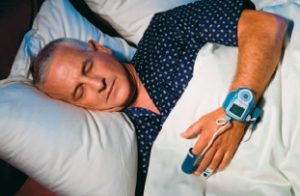 More than 23 million people in the United States have undiagnosed sleep apnea, which is kind of a staggering number given how simple testing has become. The Comprehensive Sleep Disorders Center at Trinitas, located at the Homewood Suites by Hilton, in Cranford, was seeing a steady stream of patients prior to the COVID-19 pandemic. While seeing patients and monitoring their sleep on-site became problematic in the spring of 2020, the center was able to shift gears and ramp up its home testing for sleep apnea thanks to a portable diagnostic device called the WatchPAT®, a small piece of equipment with three components. The PAT stands for Peripheral Arterial Tonometry, which measures arterial pulse volume changes to detect apnea events.
More than 23 million people in the United States have undiagnosed sleep apnea, which is kind of a staggering number given how simple testing has become. The Comprehensive Sleep Disorders Center at Trinitas, located at the Homewood Suites by Hilton, in Cranford, was seeing a steady stream of patients prior to the COVID-19 pandemic. While seeing patients and monitoring their sleep on-site became problematic in the spring of 2020, the center was able to shift gears and ramp up its home testing for sleep apnea thanks to a portable diagnostic device called the WatchPAT®, a small piece of equipment with three components. The PAT stands for Peripheral Arterial Tonometry, which measures arterial pulse volume changes to detect apnea events.
“It comfortably sticks to the chest with a small sensor, straps on your wrist like a watch, and slips onto your pointer finger,” says Dr. Vipin Garg, Director of the Comprehensive Sleep Disorders Center. “While you sleep, information is collected by the device and sent through the WatchPAT app to your doctor. Theoretically, if I was your doctor, I would be able to look at the results of your sleep test as soon as you woke up and hit send on the app from your phone.”
Sawing Wood
 Nearly half of all adults snore occasionally. About a quarter snore regularly. Often, snoring is the result of a treatable condition, such as a sinus infection or a deviated septum. The culprit may also be bulky throat muscles or a soft palate or uvula. And, of course, in cases when loud snoring or gasps are interspersed with pauses in breathing—sometimes 20 or 30 an hour—sleep apnea is a strong possibility.
Nearly half of all adults snore occasionally. About a quarter snore regularly. Often, snoring is the result of a treatable condition, such as a sinus infection or a deviated septum. The culprit may also be bulky throat muscles or a soft palate or uvula. And, of course, in cases when loud snoring or gasps are interspersed with pauses in breathing—sometimes 20 or 30 an hour—sleep apnea is a strong possibility.
One more annoying thing about growing old is that we are more likely to snore as we age or go through physical changes. Middle-aged men and postmenopausal women are more likely to snore where they hadn’t in the past, and weight gain is connected to increased snoring.
Whatever the reason, the sleep deprivation that often goes hand-in-hand with snoring can come with its own health and wellness issues, and has been linked to obesity, heart disease and diabetes.
So who are these 23 million undiagnosed sleep apnea sufferers? If you snore, you may be one of them…and a candidate for a sleep apnea test. Snoring in and of itself is bad enough, even if it can be blamed on your anatomy, allergies, your sleep position or something else entirely. Snoring is unhealthy because when you stop breathing your oxygen level drops and makes it difficult for your brain and heart to function properly. With sleep apnea, you actually stop breathing—possibly several times per hour—which means interrupted sleep for you and anyone within earshot.
Dr. Garg says snoring “isn’t the only red flag to look out for.” There is also morning headaches, dry mouth, mood changes, pauses in breathing, snorting or gasping, insomnia, irritability and depression. Sleep apnea can lead to high blood pressure, stroke, cardiac problems, asthma, COPD and diabetes mellitus. It also causes a low oxygen level known as hypoxia, which creates a fight-or-flight response, meaning that your quickening heart beat also narrows your arteries. Undiagnosed sleep apnea also raises your risk of stroke by two or three times. You may also be at a higher risk of cardiac issues if you are older than 60, have 20 or more episodes of sleep apnea per hour and have an oxygen level of less than 78 percent while you sleep.
There are three types of sleep apnea that Dr. Garg and his sleep center staff look for when they test. Central Sleep Apnea means your brain isn’t signaling your muscles to breathe. Obstructive Sleep Apnea, which is most common, is a blockage in your airway. Complex Sleep Apnea syndrome is a combination of the two.
If you need to be treated for sleep apnea, the choice with which most people are familiar is the CPAP, short for Continuous Positive Airway Pressure. It’s a small, portable machine that keeps the upper airway open when you wear a small mask over the nose. A nasal mask is attached to the machine with tubing. It’s not as uncomfortable as it sounds and it’s most definitely the kind of thing one can get used to—and actually prefer to sleep with—to make breathing easier. The global CPAP market has been estimated at over $2 billion annually, with more than a quarter sold in the U.S.
 There are some instances where surgery is the best option. For instance, removing the adenoids and tonsils—which is the most common treatment of Obstructive Sleep Apnea in children—nasal polyps or anything else blocking the airway can solve the problem. You may also be a candidate for an uvulopalatopharyngoplasty (UPPP) to remove the excess tissue from the back of the throat.
There are some instances where surgery is the best option. For instance, removing the adenoids and tonsils—which is the most common treatment of Obstructive Sleep Apnea in children—nasal polyps or anything else blocking the airway can solve the problem. You may also be a candidate for an uvulopalatopharyngoplasty (UPPP) to remove the excess tissue from the back of the throat.
No matter what you and your doctor decide, the path to a better night’s sleep begins with testing. And testing begins at home.

Editor’s Note: The Comprehensive Sleep Disorders Center at Trinitas was the first hotel-based sleep center in New Jersey. For more information call Dr. Garg at (908) 994-8694.
Crazy 8
 In a day and age when social media and family drama pulls us in so many directions, and the line between work and home is increasingly blurred, the idea we grew up with—“everyone needs eight hours of sleep”—would almost seem quaint if it didn’t sound so crazy. And while some people can truly thrive on five or six hours a night, sleep experts maintain that the traditional range of seven to nine hours a night is still a solid number. Seniors can get away with slightly less, while children actually need more for proper growth and development. So when your teenager is heading into his or her tenth hour of unconsciousness, don’t take it personally. It’s just nature doing its job.
In a day and age when social media and family drama pulls us in so many directions, and the line between work and home is increasingly blurred, the idea we grew up with—“everyone needs eight hours of sleep”—would almost seem quaint if it didn’t sound so crazy. And while some people can truly thrive on five or six hours a night, sleep experts maintain that the traditional range of seven to nine hours a night is still a solid number. Seniors can get away with slightly less, while children actually need more for proper growth and development. So when your teenager is heading into his or her tenth hour of unconsciousness, don’t take it personally. It’s just nature doing its job.
If you sense that you’re not getting enough sleep, trust your instincts and talk to a doctor. Research shows that six hours or less can increase anxiety, affect your decision-making and create a general fog that is unpleasant and potentially dangerous. Sleep apnea is not a slam-dunk diagnosis. It may be that you play a lot of sports or have a labor-intensive job, or that you’re hitting the caffeine a little too hard. There may be a coexisting health issue.
An insider’s guide to taking your temperature.
The most-measured quantity on earth is time. That makes sense. However, did you know that the second most-measured quantity is temperature? Think of all the devices that monitor hot and cold in your life, from the ones that regulate your heating and cooling system and your car, to the ones in your kitchen appliances and your computer. And, of course, there is one of the most important pieces of medical equipment in your home—the clinical thermometer—which measures body temperature and is the subject of this story.
 Interestingly, what all of the aforementioned measuring devices have in common is that they share a single ancestor, one that looked a lot like the old glass-and-mercury thermometer, which, not for nothing, should no longer be in your medicine cabinet (but probably still is). More on this in “Getting Rid of Mercury” on page 43.
Interestingly, what all of the aforementioned measuring devices have in common is that they share a single ancestor, one that looked a lot like the old glass-and-mercury thermometer, which, not for nothing, should no longer be in your medicine cabinet (but probably still is). More on this in “Getting Rid of Mercury” on page 43.
Taking your temperature (or someone else’s) doesn’t involve much in the way of experience or artistry. However, there are a few hard and fast rules that are easy to forget if you’re not feeling well. For example, if you’re taking your temperature orally, wait a good 15 to 30 minutes after eating or drinking to get an accurate reading. If you’ve taken a medication designed to lower a fever, like Tylenol, wait six hours before using a thermometer to ensure your numbers are correct. And if you take your temp under the armpit, remember it must touch skin and not clothing (a surprisingly common mistake).
“Normal” temperatures for an adult range between 97 and 99 degrees. The range is slightly broader for children—95.9 to 99.5—while the normal range for infants is a tick higher at 97.9 to 100.4. According to Cheryl Meyer, RN, CEN, Assistant Director of the Trinitas Emergency Department, an infant with a temperature above 100.4 should be seen right away by a medical professional. The same goes for children with a fever above 102 and an adult with a temperature north of 103. A low-grade fever lasting more than a few days is also worth a call to your physician.
What does a fever mean? It means your body is fighting an illness (such as a virus) or infection of some kind. Fevers are often accompanied by other symptoms—typically chills, headaches and body aches, but also more severe symptoms, including vomiting, diarrhea and convulsions. COVID-19 symptoms, as we all know by now, are often characterized by a dry cough, exhaustion and breathing difficulty. There are ways to check for a fever without a thermometer, but they are unlikely to be accurate, especially if you are feeling your own forehead.
What does a high temperature reading tell you?
“It is usually indicative of infection and/or sepsis,” says Meyer. “However, a high temperature also could reflect an exposure to heat—such as when a child is left in a car…or if someone is left exposed to the heat for a long time, due to a medical emergency or accident, and they can’t seek shelter. Whatever the cause, you need to seek immediate medical attention.”
What can an unusually low temperature tell you? Meyer says that it can be the result of exposure to the environment—“such as our homeless population or someone who maybe was confused and got lost in and was exposed to the cold.” Be aware that it also can be caused by sepsis and/or infection, she adds.
Thermometer Basics
Thermometers take a patient’s temperature in five different ways, and each has a name: Oral/Sub-Lingual (under the tongue), Axillary (under the armpit), Rectal (in the rectum), Tympanic (in the ear) and Temporal (on the forehead). There are two essential parts to any medical thermometer, the sensor and the means of converting the result into something readable. For glass or plastic thermometers, the sensor is that  little bulb located on the business end of the thermometer. For infrared thermometers, a pyrometric sensor gathers the data. Once a reading is complete, you get a number—either as a digital readout, or using those hashmarks on an old-school thermometer.
little bulb located on the business end of the thermometer. For infrared thermometers, a pyrometric sensor gathers the data. Once a reading is complete, you get a number—either as a digital readout, or using those hashmarks on an old-school thermometer.
Okay, let’s get this part out of the way. The most accurate temperature reading is the rectal one. It is still the method of choice for infants. And also animals. Most people find oral temperature-taking boring or unpleasant, but for adults and children capable of keeping the thermometer under the tongue, this is the method of choice. If a person is unconscious or coughing heavily, sub-lingual may not be the answer, even with fast-reading digital models. In these cases, medical professionals choose between the ear and the armpit. An axillary reading can take five-plus minutes to be accurate and, even at that, many doctors mentally add a degree.
Getting Rid of Mercury
 Do you have an old-school mercury and glass thermometer in your medicine cabinet? If so, be aware that it contains half a gram of elemental mercury. That’s not enough to kill you (or even seriously harm you) if you somehow swallowed it (the vapors from the mercury are actually far more harmful), but all the mercury adds up when people start throwing their old thermometers away by the tens of millions. To properly dispose of a mercury thermometer, place it inside a plastic container or glass jar, fill the container with something oil-absorbent (like cat litter or sand) and mark it “Contains Mercury” with a Sharpie. Your town or county will have a hazardous chemical drop-off site where you can dispose of it properly.
Do you have an old-school mercury and glass thermometer in your medicine cabinet? If so, be aware that it contains half a gram of elemental mercury. That’s not enough to kill you (or even seriously harm you) if you somehow swallowed it (the vapors from the mercury are actually far more harmful), but all the mercury adds up when people start throwing their old thermometers away by the tens of millions. To properly dispose of a mercury thermometer, place it inside a plastic container or glass jar, fill the container with something oil-absorbent (like cat litter or sand) and mark it “Contains Mercury” with a Sharpie. Your town or county will have a hazardous chemical drop-off site where you can dispose of it properly.
Temporal thermometers are simple to use and very accurate between 97 and 100. Which, if you’re curious, is how that random dude at the front of Trader Joe’s became, literally, a front-line worker last year. A similar device is now being used on wrists instead of foreheads. Recent studies have shown that it is 95% accurate in terms of fever-screening ability—the same or better than forehead readings. Wrist scanners work because the artery is very close to the surface of the skin.
The Road to 98.6
Most of us have been ingrained with the knowledge that the ideal human body temperature is 98.6 degrees. Did you ever wonder who decided this, and how? It was a German physician and psychiatrist named Carl Wunderlich in the 1860s. He averaged out over a million (mostly armpit) readings and determined that the temperature of healthy people fell between 97.3 and 99.5, with an average within that range of 98.6.
Medical professionals are quick to point out that your temperature is usually lower in the morning than in the afternoon, often by a degree or more, so there is no reason to be wed to 98.6, other than it has been drilled into our heads since childhood. Many believe the more accurate average number is between 97.5 and 97.9. Why the drop? In the century-plus since Wunderlich’s time, humans have gotten fatter and have lower metabolic rates. The less heat your body has to make to keep all its parts going, the lower your temperature will be.
 While we’re on the topic of history, it’s worth noting that the basic principles behind the thermometer were known in ancient Greece more than 2,500 years ago. However, the first device you’d think of as approaching a “modern” thermometer was pioneered by Santorio Santorio (right) at the University of Padua in the early 1600s. Galileo, who was on a first-name basis with the professor, is believed to have had some input—as did other scientists who were exchanging ideas in Venice at the time. Temperature-taking was all the rage in 17th century Europe, it seems. Santorio’s invention used the expansion of water, not mercury, to show changes in temperature and was called a thermoscope. It became a thermometer after a standardized scale was added. The first scale measured only eight different “degrees.”
While we’re on the topic of history, it’s worth noting that the basic principles behind the thermometer were known in ancient Greece more than 2,500 years ago. However, the first device you’d think of as approaching a “modern” thermometer was pioneered by Santorio Santorio (right) at the University of Padua in the early 1600s. Galileo, who was on a first-name basis with the professor, is believed to have had some input—as did other scientists who were exchanging ideas in Venice at the time. Temperature-taking was all the rage in 17th century Europe, it seems. Santorio’s invention used the expansion of water, not mercury, to show changes in temperature and was called a thermoscope. It became a thermometer after a standardized scale was added. The first scale measured only eight different “degrees.”
Over the next century, scientists tinkered with non-water liquids, including brandy. In 1701, Isaac Newton proposed that thermometers be standardized to measure the difference between the melting point of ice and the temperature of the human body, with 12 degrees separating the two measurements. In 1714, a Dutch inventor found mercury to be the most reliable and sensitive thermometer-filler. His name was Daniel Fahrenheit and he made a nice living manufacturing mercury thermometers. In 1742, a Swedish physicist proposed a new temperature scale, which used 100 to express the freezing point of water and 0 for the boiling point of water. His name was Anders Celsius (right), and his colleagues loved the idea…with one small tweak: They flipped the script, making 0 the cold end and 100 the hot end. Outside of the academic community, almost no one in America has the faintest idea how Celsius works, so don’t feel bad.
physicist proposed a new temperature scale, which used 100 to express the freezing point of water and 0 for the boiling point of water. His name was Anders Celsius (right), and his colleagues loved the idea…with one small tweak: They flipped the script, making 0 the cold end and 100 the hot end. Outside of the academic community, almost no one in America has the faintest idea how Celsius works, so don’t feel bad.
 The first doctor who stuck a thermometer into a person as part of his patient practice was Herman Boerhaave (left), a Dutch chemist and physician who founded the first European teaching hospital at the University of Leiden in the early 1700s. His patients were none too thrilled about the idea—it took up to a half-hour to obtain an accurate reading, so no matter the input, the process was tedious and unpleasant. And if you think that’s a long time, consider that it took 150 more years to cut the temperature-taking times down to five minutes.
The first doctor who stuck a thermometer into a person as part of his patient practice was Herman Boerhaave (left), a Dutch chemist and physician who founded the first European teaching hospital at the University of Leiden in the early 1700s. His patients were none too thrilled about the idea—it took up to a half-hour to obtain an accurate reading, so no matter the input, the process was tedious and unpleasant. And if you think that’s a long time, consider that it took 150 more years to cut the temperature-taking times down to five minutes.
That breakthrough came after years of tinkering by a British scientist named (I swear I am not making this up) Thomas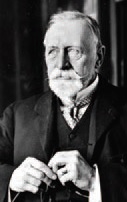 Allbutt (right). Just as thrilling was the fact that his clinical thermometer was only six inches long—half the (yikes) standard length during the early 1800s. Later in life, Allbutt was rewarded for his ingenuity by being appointed a Commissioner of Lunacy for England and Wales. Oh, and by the way, if you think wearing a mask and getting your forehead scanned is annoying, imagine waiting in line to get into Whole Foods only to encounter a 12-inch thermometer at the front door!
Allbutt (right). Just as thrilling was the fact that his clinical thermometer was only six inches long—half the (yikes) standard length during the early 1800s. Later in life, Allbutt was rewarded for his ingenuity by being appointed a Commissioner of Lunacy for England and Wales. Oh, and by the way, if you think wearing a mask and getting your forehead scanned is annoying, imagine waiting in line to get into Whole Foods only to encounter a 12-inch thermometer at the front door!
New Temp Tech
Thankfully, about 20 years ago, the temporal artery thermometer was unveiled by Exergen. A two-second forehead scan is all that’s needed to obtain an accurate temperature now. Dr. Frank Pompeii, who has a wall full of degrees from Harvard and MIT, developed this technology in the 1990s. Before forehead-scanning devices became affordable, you may recall that electronic ear thermometers—which measure blood temp with an infrared probe—were very popular. They came on the market in the late-1960s, courtesy of a German doctor named Theodor Benzinger, who emigrated to the U.S. after World War II and went to work for the Navy. He was actually experimenting with ways to measure brain temperature without the use of electrodes. Benzinger determined that the blood vessels coursing through the ear drum are shared with the hypothalamus, the part of the brain that regulates body temperature. The drawback to ear thermometers is that they can fail to detect a fever if a patient has significant wax build-up, or the probe records the temperature of the external ear canal and not the part containing the ear drum’s blood vessels.
 In conclusion, and to underscore an earlier point, the newer, safer methods for temperature-taking have made the mercury-and-glass thermometer entirely obsolete. Starting around 20 years ago, states began banning their sale and the National Institute of Standards and Technology stopped calibrating mercury thermometers a decade ago.
In conclusion, and to underscore an earlier point, the newer, safer methods for temperature-taking have made the mercury-and-glass thermometer entirely obsolete. Starting around 20 years ago, states began banning their sale and the National Institute of Standards and Technology stopped calibrating mercury thermometers a decade ago.
Although mercury is arguably the most beautiful and captivating of the elements, it also happens to be a neurotoxin that is almost impossible to clean up once it escapes its container. It’s bad stuff, so please say goodbye to your mercury thermometer if you haven’t already.
Editor’s Note: From the “Don’t Try This at Home” Department, the highest recorded human temperature was 115.7 degrees. Willie Jones of Atlanta set the record during a summer heat wave in 1980 and suffered no apparent ill effects. “Based on studies,” his doctor told reporters at a press conference, “Mr. Jones should not be sitting here next to me. He was as close to death as anyone gets.”
Seeing Red
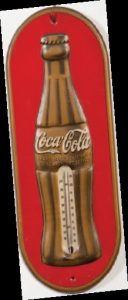
 Mercury isn’t the only substance used in thermometers. Think of all the souvenir and advertising thermometers you’ve seen in your life. Some people actually collect them. The red stuff they contain is dyed alcohol or ethanol. It’s not as accurate as mercury and is not dangerous if the thermometer breaks. The substance is accurate up to 172 degrees, so it’s really only good for measuring air and body temperature.
Mercury isn’t the only substance used in thermometers. Think of all the souvenir and advertising thermometers you’ve seen in your life. Some people actually collect them. The red stuff they contain is dyed alcohol or ethanol. It’s not as accurate as mercury and is not dangerous if the thermometer breaks. The substance is accurate up to 172 degrees, so it’s really only good for measuring air and body temperature.
The ability to light up a screen is not the exclusive province of A-List, big-box-office mega-stars. Some actors have learned to wield that quality with understated strength and subtlety—and parlayed that power into long, distinguished entertainment careers. If you’re wondering why Elizabeth Perkins is so relentlessly good in everything she does, you may have just answered your own question. For three-plus decades she has turned in luminous performances in heart-tugging dramas and smart comedies that include About Last Night, Big, Avalon, The Doctor, He Said She Said, The Ring Two, 28 Days and Must Love Dogs—as well as unforgettable TV series like Weeds, Sharp Objects, How to Live with Your Parents and Truth Be Told. She also played Nemo’s mom in Finding Nemo. Perkins has inhabited screen characters that run the gamut from dark to daring to devilishly funny. But as she tells Gerry Strauss, in her current FOX series, The Moodys, she is playing a version of someone fans have never seen before: herself.
 EDGE: In the FOX series The Moodys, you play Ann Moody, an alcohol counselor. There’s a personal story behind that.
EDGE: In the FOX series The Moodys, you play Ann Moody, an alcohol counselor. There’s a personal story behind that.
EP: I asked them to let my character go back to school and become a counselor because of what my mother had done. She was a pianist and then she became an alcohol rehabilitation counselor. She had played in a series of bars and was in that scene, became a full-blown alcoholic throughout most of my childhood, and then got sober when I was 18 or 19 years old. She completely turned her life around, went back to school, got her degree and became a counselor. Sobriety has been a big part of my life, and so is recognizing that and honoring that in people and in my family, and in myself. It was a real inspiration for my character on this show for that very reason.
EDGE: Your mom was an entertainer at heart. Did that influence you early on?
EP: Oh, 100 percent. My mother used to play the piano and I would stand next to her and sing. She always encouraged me to do the things that she couldn’t—or wouldn’t, or didn’t—and was really an impetus for me to get on stage. She introduced me to local theater in our small town in Massachusetts and was always my inspiration. She would say to me, “I wish that I had done that when I was your age.” Because she was a natural performer…and the funniest person I’ve ever known in my life. She was sarcastic and raucous and bawdy. She was just no-holds-barred, with a great deal of confidence. I think that my sense of humor comes directly from her mouth. For sure.
EDGE: You began your career as a stage actress, correct?
EP: Oh, absolutely. I went to drama school in Chicago at the Goodman School of Drama, which now has been incorporated into DePaul University. But when I went there, it was a conservatory, and I think we had a graduating class of 12 people. When you’re in that kind of training program, specifically back then, they weren’t training you for television and film. We didn’t have on-camera classes or how-to TV audition classes. It was primarily performing on the stage. I had really not thought about film and television. When you come from a conservatory mindset like that, it’s all about the theater. I was lucky enough—and I’ll use that word lucky, because luck does play a huge part in any actor’s life—to be seen. I went to New York solely to do theater and was cast on Broadway. That was 100 percent luck and being at the right place at the right time. I was proud of myself working on Broadway, being young in my twenties, in New York.
 EDGE: Then came About Last Night (above), with Rob Lowe, Demi Moore and Jim Belushi…
EDGE: Then came About Last Night (above), with Rob Lowe, Demi Moore and Jim Belushi…
EP: Again, I just lucked into that first film audition, which I think it was 1985. It had never occurred to me to do film and television, and I was perfectly fine without it. I just fell into it. When I did About Last Night, I’d never been in front of a camera before. I’d never done a commercial or a day part. I’d never even done a student film before, so I sort of faked my way through it. I remember arriving on the set and they were using terms that I’d never heard: your mark, the POV, the cheap shot, over-the-shoulder. I just was like, “I’m going to just fake it till I make it.”
EDGE: And you did. You were listed as one of the “12 Most Promising New Actors of 1986” in Screen World, which was a huge deal back in the pre-Internet and pre-IMDB days. Did you feel some pressure at that point to keep the momentum going?
EP: I felt a little overwhelmed. The film got a lot of attention and the way I looked at it was like, “Well, that’s intense.” But it resulted in me getting more work. I had been living in New York in my twenties and everything was expensive, and I wasn’t making any money. It just translated into, “Oh, I can buy my mom a car!” That’s when I started buying my mom her cars, and I bought her a new car like every five years for the rest of my life, until she passed away a few years ago. Then I remember thinking, “I can buy my mom a house…I can do all these things. I can now help take care of my mom the way she always took care of me.” So it was a blessing. I was 26, but I think I had a pretty good head on my shoulders about it, and I knew these things come and go so quickly. It’s like that great line in Notting Hill: “Today’s newspapers are going to line tomorrow’s canary cage.”
EDGE: Not everyone in that situation would respond that way.
EP: If you’re in it for a certain amount of notoriety, yeah, that could sway how you respond to that attention. A lot of actors who think, Oh, I’m the hottest thing right now—and they actually think that’s going to last—just aren’t really living in reality. Hype is so fleeting, and all you can really do is focus on the work. I’m from a really small town in Western Massachusetts, so all of this was just great [laughs]. I’ll take whatever I can get! I remember when I was making The Flintstones with Rosie O’Donnell, she was hanging out with Madonna at the time and she said, “You could just be so much more famous than you are. You should come out with me and Madonna… you could be super famous. Your career could be so much better than it is right now.” And I remember thinking to myself, I like my career right now. [laughs] I work all the time, but I’m not one of those people who’s surrounded by paparazzi. I work with great people. I make good money. I’ve got four children. I support myself. I’ve supported my parents. Yeah, I guess you could be wanting to be in that level of superstardom…or you can just be really grateful for what’s in front of you. I think that’s sustained me. I’ve been doing this for over 35 years, and I’m good.
EDGE: One of your earliest film roles was opposite Tom Hanks in Big. In 1988, it was an innocent family-friendly fantasy film. Do you think the relationship between your adult character and Josh, who was still a 12-year-old boy, would be done the same way?
EP: Oh, I get questions about this all the time, because we have sex in the movie. He kisses me and touches my breasts, and it was a whole thing. Yeah…we wouldn’t shoot that movie like that today, 100 percent. I’m not sure I feel strange about it in hindsight. That scene was primarily to set up the joke of the next day at the office, when the elevator opens and he walks out like, Oh, I’m a completely changed human being. It in no way indicated any kind of untoward, Oh, she’s having sex with a minor. Based on how we have grown for the good as a society, that scene would probably not be acceptable, period, so I own that. And I’m sure Penny [Marshall, who directed the film], before she passed, would own that as well.
EDGE: Do you view the heightened sensitivity towards entertainment as being a change for the better?
EP: I think when change happens, societal change happens. It goes to the extremes in many different directions and then eventually it finds its home. The change that’s going on now is very necessary, but I do think we’re all still finding our footing there. In terms of certain norms that have gone on for decades, it’s a hard change for everyone, particularly people who’ve been writing or directing or creating for years. But it’s a necessary one. My daughter works in development at the Geena Davis Institute for Gender in Media and she’s my touchstone for all of it. I’m 60 years old. I’ve been doing this since I was in my early 20s. And every time I have a question, I call her and I say, “What do you think about this?” It’s all a big change for me, too. I really applaud my daughter, because she’s at the forefront of working for an institute that is dedicated to equality and inclusivity and diversity. And it’s really needed, and it’s overdue at this point.
EDGE: Is comedy something that you’ve always enjoyed digging into, or was it more of an acquired passion?
EP: Oh, I adore doing comedy. If I could do comedy all the time, I would really be in a sweet spot. Sometimes I feel like I’m always given the job I need at the moment I need it. Prior to doing The Moodys with Denis Leary, I had done all these really dark things. I did a show called Sharp Objects with Amy Adams and Patricia Clarkson. That was so dark. Then I did a show with Aaron Paul and Octavia Spencer that was just Nazis and prison and racism. And then Trump was in office and the pandemic hit, and I’m doing comedy. If you just stay in these dark pieces, you bring it home with you. I do, anyway. So I just feel blessed that I’m making a comedy in the middle of all of this stuff. I’m like, “Okay, universe, you’re giving me exactly what I need.” [laughs]. It’s great to wake up in the morning and know that you’re going to go to work and laugh—I’m so blessed to be working with Denis and Jay Baruchel, who plays our oldest son. Jay is just wicked good. He’s incredible. We’re having such a good time that none of us wants to leave.
EDGE: What specifically hooked you into The Moodys?
EP: Denis Leary. Denis and I grew up about 30 miles away from each other. Chelsea Frei, who plays our daughter, grew up another 30 miles away, and Jay Baruchel is from Montreal, which is like four hours away. So all of us really have this same sort of—I’ll use the word “wicked” because that’s New England lingo— sense of humor, and we’re all from working-class families. So, when the creators sent it to me, they said, “There’s not a lot on the page right now, but we’d love you to do this.” And I said, “Well, can I make her like me?” And they were like, “Yeah.” So they were gracious enough to let me infuse my own life into it. I feel like this is the first time that I’ve created someone who’s really based on me, a woman with older children who are still in and around the house, who’s trying to reinvent herself all the time—which happens when you go from being a mother to being an empty nester. I was able to infuse parts of my mom into it, and so it was the first time I’ve been able to have open season on a character that the creators really allowed me to make my own. At my age, it was really a little gift for me. I took it and ran with it, and I’m having a ball.
EDGE: Would the prospect of creating your own character have frightened you earlier in your career?
EP: Oh, yeah. But everything is scarier when you’re younger.
EDGE: Why does it work so well now?
 EP: When you get to be a certain age, you don’t care what people think anymore. You just don’t. You’ve been around for long enough to just say, “I am who I am, and I’m proud of who I am.” I love these parts of myself, and I want to share them because I think I’m really great. I do. I love my life. I love my husband. I love my kids. I just feel like I’ve been given so many gifts. And now I’m getting to play a really great part of myself. A lot of people don’t get an opportunity like that, so I adore my creators and Denis for bringing me along on this. They’re allowing me to be nutty and obsessive and fun—a woman who maybe has too many glasses of wine, or maybe overdecorates the house at Christmas, who might be a little bit cloying at times when it comes to her children. These are all real facets of me.
EP: When you get to be a certain age, you don’t care what people think anymore. You just don’t. You’ve been around for long enough to just say, “I am who I am, and I’m proud of who I am.” I love these parts of myself, and I want to share them because I think I’m really great. I do. I love my life. I love my husband. I love my kids. I just feel like I’ve been given so many gifts. And now I’m getting to play a really great part of myself. A lot of people don’t get an opportunity like that, so I adore my creators and Denis for bringing me along on this. They’re allowing me to be nutty and obsessive and fun—a woman who maybe has too many glasses of wine, or maybe overdecorates the house at Christmas, who might be a little bit cloying at times when it comes to her children. These are all real facets of me.
What’s fueling the rush to install home pizza ovens?
One of the triumphant survivors of COVID-19 in New Jersey was the old-school pizzeria. Only a handful of these stores shuttered and many actually saw an uptick in business. The curbside pick-up/home-delivery model had already existed for decades when thousands of restaurants in the state were forced to adapt or die. This gave pizza-makers a huge edge when everyone went into hunker-down mode.
But I know another reason why pizza-makers made it through with flying colors: We learned just how impossible it is to make a decent pie in a standard oven.
 Some of us have come tantalizingly close, but it’s never quite right, is it? Even the most talented home chefs with “professional” equipment and designer kitchens eventually arrived at this conclusion. In fact, I’ll bet they were the first to pick up the phone and order out once it was safe. So how do you make an honest-to-goodness pizza-parlor pie at home? With an honest-to-goodness pizza oven.
Some of us have come tantalizingly close, but it’s never quite right, is it? Even the most talented home chefs with “professional” equipment and designer kitchens eventually arrived at this conclusion. In fact, I’ll bet they were the first to pick up the phone and order out once it was safe. So how do you make an honest-to-goodness pizza-parlor pie at home? With an honest-to-goodness pizza oven.
Your first steps on this journey begin with finding an oven that meets all the necessary criteria and lines up with your budget, kitchen space and other needs. If you’ve got a buddy in the business, obviously that’s an excellent place to start, but for most of us the Internet is where the search 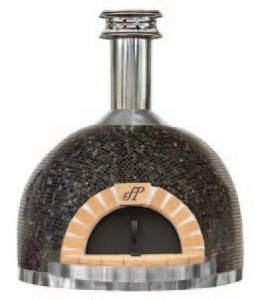 begins. Google “pizza oven suppliers” and you’ll notice that the word forno—which translates as “oven”—appears in many trade names. Examples include Forno Bravo, a company that builds and ships from Monterey; Forno Piombo, a father-and-son team that annually produces only 160 custom ovens (starting at $9,500) that are inspired by Tuscany but handcrafted in the Napa Valley; and Fontana Forni, which offers made-in-Italy models using techniques crafted by generations of the Fontana family.
begins. Google “pizza oven suppliers” and you’ll notice that the word forno—which translates as “oven”—appears in many trade names. Examples include Forno Bravo, a company that builds and ships from Monterey; Forno Piombo, a father-and-son team that annually produces only 160 custom ovens (starting at $9,500) that are inspired by Tuscany but handcrafted in the Napa Valley; and Fontana Forni, which offers made-in-Italy models using techniques crafted by generations of the Fontana family.
Pie Chart
 Three billion pizzas are sold in the US each year accounting for $40 billion in revenues. During the pandemic, Pizza Hut and Domino’s saw delivery and off-premises sales soar by 21% and 36% respectively. Here are some other fun facts about pizza in America…
Three billion pizzas are sold in the US each year accounting for $40 billion in revenues. During the pandemic, Pizza Hut and Domino’s saw delivery and off-premises sales soar by 21% and 36% respectively. Here are some other fun facts about pizza in America…
- 41% of Americans have pizza at least once a week
- About 12% consume pizza on any given day
- The average American will consume more than 6,000 slices in a lifetime
- There are roughly 2,000 pizza restaurants in New Jersey and nearly 70,000 in the U.S.
- In a recent poll asking consumers to name their favorite food, pizza finished fifth—behind hamburgers, hot dogs, fries, and Oreos.
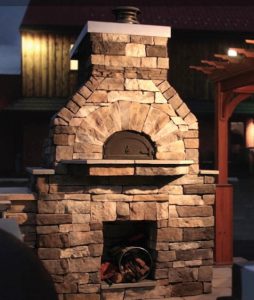 More important than finding a cool name is determining the type of oven appropriate for your situation. These are your four basic choices:
More important than finding a cool name is determining the type of oven appropriate for your situation. These are your four basic choices:
- Brick Oven A centuries-old wood-fired method capable of reaching 700-1,000°F with a rustic look and taste of days gone by. These ovens can also be heated with gas or coal, or a combination of sources.
- Deck Oven When space is at a premium, offers one to three decks made of stone heated by a gas or electric burner; not quite in the same league as a wood-fired oven, but it will look familiar if you frequent your local pizza place.
- Convection Oven You may have one already; if not, you may want to consider one on your next remodel. It circulates hot air from the bottom, which gives you a fighting chance to produce a crispy, thin crust—but it’s not made specifically for pizzas, so lower your expectations.
- Impinger Oven Uses specialized radiant cooking technology to distribute hot air from both the top and bottom to penetrate the pizza quickly and cook it in five minutes or less. You don’t typically find these in homes, but it doesn’t mean you can’t.
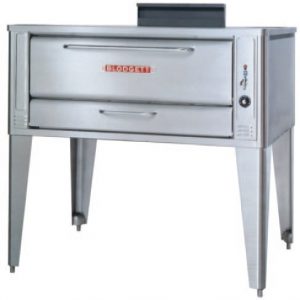 Ask any pizza aficionado and you’ll almost always be told that an authentic Italian pie can only come from a wood-fired oven with a traditional stone base. Although these ovens are not unheard-of in residential kitchens in New Jersey, you’re far more likely to find one a few steps outside the kitchen, on a patio or as part of an outdoor entertainment area. Would it surprise you to know that one of the top people in the outdoor pizza business is located in New Jersey? Decades-old Backyard Brick Ovens is right in the neighborhood, in Edison. Its owner, Scot Cosentino, is not only a master builder of wood-fired pizza ovens, but he takes pride in billing himself as a World Champion Pizza Maker. For more than 30 years, Cosentino has been designing, engineering and producing pizza ovens for sites ranging from private backyards to commercial restaurants.
Ask any pizza aficionado and you’ll almost always be told that an authentic Italian pie can only come from a wood-fired oven with a traditional stone base. Although these ovens are not unheard-of in residential kitchens in New Jersey, you’re far more likely to find one a few steps outside the kitchen, on a patio or as part of an outdoor entertainment area. Would it surprise you to know that one of the top people in the outdoor pizza business is located in New Jersey? Decades-old Backyard Brick Ovens is right in the neighborhood, in Edison. Its owner, Scot Cosentino, is not only a master builder of wood-fired pizza ovens, but he takes pride in billing himself as a World Champion Pizza Maker. For more than 30 years, Cosentino has been designing, engineering and producing pizza ovens for sites ranging from private backyards to commercial restaurants.
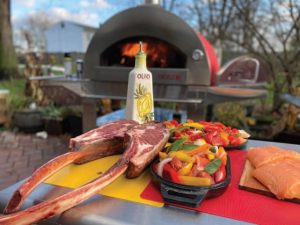 Today, the company focuses on outdoor and stand-alone installations. Its brand name is Forno Bello and its most popular model is the Neapolitan. That oven is priced at $2,800, with an additional $300 set-up fee. Cosentino offers videos to his customers with instructions on setting up, lighting up, doughing up and dishing up his favorite recipes. He confirms that the pandemic has hardly dented the business, as many New Jersey families chose to invest in their homes over the past year: “Backyard ovens sold like hot pizzas during the pandemic.”
Today, the company focuses on outdoor and stand-alone installations. Its brand name is Forno Bello and its most popular model is the Neapolitan. That oven is priced at $2,800, with an additional $300 set-up fee. Cosentino offers videos to his customers with instructions on setting up, lighting up, doughing up and dishing up his favorite recipes. He confirms that the pandemic has hardly dented the business, as many New Jersey families chose to invest in their homes over the past year: “Backyard ovens sold like hot pizzas during the pandemic.”
Okay, let’s stop for a second. I have never experienced daily cravings like I did while researching this story, so let’s talk about the kind of pizza that comes out of a great oven. The most basic traditional pizza is a margarita, which at its best is prepared with a thin crust generously topped with patiently simmered fresh tomato sauce and finished with generous slices of fresh bufalo mozzarella and an aromatic chiffonade of basil leaves. A less common, but equally traditional option often found on more sophisticated menus is the Pizza Quatro Stagioni. To live up to its label, this pizza is divided into four quarters, each symbolizing one of the seasons by featuring a vegetable typical of the time of year (e.g., artichokes for spring, mushrooms for fall, tomatoes and basil for summer, and prosciutto and olives for winter). Once again, all ingredients are crowned with a fresh tomato sauce drizzled over a thin crunchy crust.

If neither of these more orthodox versions excites your palate, the variety of pizza toppings available is limited only by the creative spirit of the resident pizzaiolo. Your pie of choice might reflect your mood (“I feel like…”), your budget (Wait, 30 bucks for what…”), or even the time of day (“I’ll have the Florentine breakfast pizza with bacon, eggs and spinach…”). I learned there is such a thing as a dessert pizza, too.
When I mentioned to my son how hungry this story was making me, he showed up with my grandson and a Ninja Foodie and we shopped for ingredients to create a couple of small, homemade pies on my countertop. Although certainly not wood-fired and perfect, they were okay. Which is something we all love about pizza: even when it’s just okay, it’s still pretty good.
A Slice of History
We all know that pizza originated in Italy, but where does the name come from? Etymologically, the word pizza is derived from the Latin pinsere, which means to pound or stamp—which became pinza and then pizza. Anyone who has watched a pizzaiolo (or pizza master) at work appreciates that making pizza requires much serious pounding of dough, followed by skillfully draping it over the closed fists of both hands and rotating it to stretch it to the proper circumference and thinness.
The first description of pizza dates back to a 10th century Latin manuscript from a town in Southern Italy. Although many Sicilian-Americans claim owner-ship on this basis, the modern pizza actually traces its roots to Naples. In fact, a non-profit organization,
The True Neapolitan Pizza Association, was founded in 1984 to safeguard Napoli as the true pizza source. As a further fact, in 2017 UNESCO awarded the Neapolitan pizza its seal of approval by listing it as “intangible cultural heritage.” It is no surprise that actor Stanley Tucci, for the first episode of CNN’s Searching for Italy, opened with a visit to Naples for meetings with a family of mozzarella cheese makers, several San Marzano tomato experts, and some very famous pizzaioli as a proper introduction to the authentic roots of pizza in its native habitat.
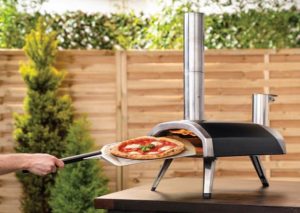 Back to business. If you prefer an indoor pizza installation, the options at the low end begin with electric, compact, and countertop ovens that can start as low as $299. The Ooni Fyra is a popular pick at that price point. If you are willing and able to make a $999 investment, the Breville Pizzaiolo model qualifies as a very high-temp “smart” pizza oven. With no unique set-up involved, these ovens can sit on any flat surface in the kitchen to quickly turn out crispy 12-inch pizzas, whether you’ve made them yourself or grabbed one out of the freezer.
Back to business. If you prefer an indoor pizza installation, the options at the low end begin with electric, compact, and countertop ovens that can start as low as $299. The Ooni Fyra is a popular pick at that price point. If you are willing and able to make a $999 investment, the Breville Pizzaiolo model qualifies as a very high-temp “smart” pizza oven. With no unique set-up involved, these ovens can sit on any flat surface in the kitchen to quickly turn out crispy 12-inch pizzas, whether you’ve made them yourself or grabbed one out of the freezer.
Although there are more sophisticated indoor ovens available, their installation requirements are more complicated and therefore more expensive. Typical kits are available from $1,500 to $2,500, but if kitchen remodeling is necessary to install, the average costs to the homeowner is likely to fall into the $15,000 to $20,000 range, which includes carpentry, tiling and electrical costs, as well as permitting and compliance with local ordinances. And as anyone who’s redone a kitchen knows, you can easily blow through that number if you look at a contractor wrong. The outdoor option may be a bit less intrusive, but is still likely to set you back between $5,000 and $20,000.
 A final thought on “cost.” As anyone who spent time in a college dorm can tell you, the price of pizza is measured both in dollars and pounds. Think of all the empty freezer cases during the height of the pandemic; those carbs had to go somewhere. Maybe that’s why Pelotons were on back order and people started buying those black-mirror home gyms. Alas, the uncomfortable truth about our favorite comfort food is that consuming a typical pie—whether all at once or as reheated leftovers—can easily surpass 2,000 calories…and depending on the quantity of cheese on the pie, more than 200 grams of fat.
A final thought on “cost.” As anyone who spent time in a college dorm can tell you, the price of pizza is measured both in dollars and pounds. Think of all the empty freezer cases during the height of the pandemic; those carbs had to go somewhere. Maybe that’s why Pelotons were on back order and people started buying those black-mirror home gyms. Alas, the uncomfortable truth about our favorite comfort food is that consuming a typical pie—whether all at once or as reheated leftovers—can easily surpass 2,000 calories…and depending on the quantity of cheese on the pie, more than 200 grams of fat.
Is every bite worth the calories? Maybe not—if it comes out of a cardboard box from your local delivery joint or supermarket freezer. On the other hand, if you’ve crafted each ingredient by hand and it emerges bubbling from your own wood-fired, charcoal-fueled or top-of-the-line convection oven, I just have two words for you: buon appetito!
Twenty memorable movies to take your temperature by.
Is it getting warm in here, or is it just that a semi-normal summer seems within reach? After a year of bread-making, diet-busting and binge-watching, it’s hard to know what’s hot and what’s not anymore. If you’re looking for a new thread to tug on, we suggest working your way through this collection of unforgettable films.
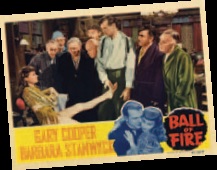 Ball of Fire • 1941
Ball of Fire • 1941
Gary Cooper plays against his brooding film hero persona in a movie about a group of musty academics grappling to understand contemporary slang as their decade-long encyclopedia project reaches the letter S. Barbara Stanwyck lived up to her billing as a ball of fire, while Cooper displayed remarkable comic timing.
 White Heat • 1949
White Heat • 1949
James Cagney transforms a low-budget gangster flick with a six-week shooting schedule into a masterpiece with a tour de force performance. His character, Cody Jarrett, was one of the first to draw a line between mental illness and criminal behavior
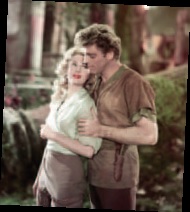 The Flame and the Arrow • 1950
The Flame and the Arrow • 1950
Burt Lancaster and Virginia Mayo co-star in this 12th century swash-buckling drama. Warner Brothers offered $1 million to anyone who could prove that Lancaster didn’t do all of his own stunts—and someone took them up on it!
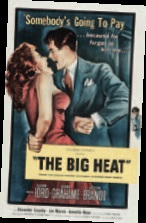 The Big Heat • 1953
The Big Heat • 1953
Glenn Ford stars as a police detective who takes on the mob in a moody and visually captivating story directed by the great Fritz Lang. Jocelyn Brando (Marlon’s older sister) played Ford’s wife and a young Lee Marvin was excellent as a psychopathic gangster.
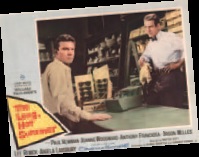 The Long, Hot Summer • 1958
The Long, Hot Summer • 1958
Paul Newman plays a Deep South drifter in a film that marked the return of director Martin Ritt from the blacklist. Newman, who was named Best Actor at Cannes, married co-star Joanne Woodward during production. Orson Welles, Angela Lansbury, Lee Remick, Richard Anderson and Tony Franciosa make up a remarkable supporting cast.
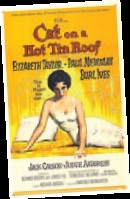 Cat On a Hot Tin Roof • 1958
Cat On a Hot Tin Roof • 1958
Elizabeth Taylor and Paul Newman play Maggie and Brick in the toned-down film adaptation of the controversial Tennessee Williams drama. Williams and Newman were both disappointed that studio censors cut out key parts of the play, but the film still earned Oscar nominations for Best Picture, Best Director, Best Actor and Best Actress.
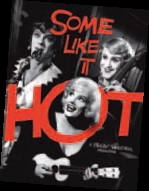 Some Like It Hot • 1959
Some Like It Hot • 1959
Jack Lemmon, Tony Curtis and Marilyn Monroe are brilliant in this gender-bending screwball comedy. Writer-director Billy Wilder never imagined the luminous Monroe would take the part, but to her enduring credit she saw how playing a ditzy “straight man“ to the inspired lunacy of Curtis and Lemmon would make the film great.
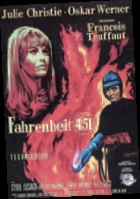
Fahrenheit 451 • 1966
Francois Truffaut directs a chilling adaptation of Ray Bradbury’s tale of a dystopian future in which “firemen” are tasked with destroying all literature; Julie Christie plays a schoolteacher who convinces a fireman to read the books he’s burning. A 2018 remake starring Michael B. Jordan and Michael Shannon lacked the oomph of this earlier production.
 In the Heat of the Night • 1967
In the Heat of the Night • 1967
Sidney Poitier and Rod Steiger originate the roles later occupied by Howard Rollins and Carroll O’Connor on the TV series of the same name. The film won the Academy Award for Best Picture and Steiger took home the Best Actor Oscar.
 Body Heat • 1981
Body Heat • 1981
Kathleen Turner and William Hurt are at their smokey, sexy best in a drama inspired by film noir classic Double Indemnity. Body Heat marked the film debut of Turner—who was best known for her role on TV soap The Doctors—and featured a supporting cast that included soon-to-be stars Ted Danson and Mickey Rourke.
 Chariots of Fire • 1981
Chariots of Fire • 1981
Of all the movies on this list, the story of two English runners at the 1924 Olympics easily has the most memorable score. It also won Best Picture. The title was inspired by a poem by William Blake, who borrowed the idea from passages in the Bible.
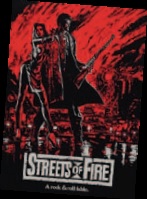
Streets of Fire • 1984
An utterly original retro rock musical, Streets of Fire is full of holes and weaknesses, yet it helped launch the movie careers of Diane Lane, Willem Dafoe, Amy Madigan, Rick Moranis, Bill Paxton and Robert Townsend. A little known fact is that it also inspired the Street Fighter video game franchise.
 St. Elmo’s Fire • 1985
St. Elmo’s Fire • 1985
This “Brat Pack” classic stars Demi Moore, Ally Sheedy, Andie McDowell, Rob Lowe, Judd Nelson, Emilio Estevez, Andrew McCarthy and Mare Winningham. The film, an attempt at a Big Chill meets Breakfast Club vibe, did well at the box office but did not win over the critics. Amazing that no one made it into a TV series.
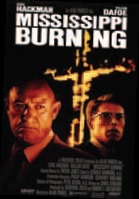
Mississippi Burning • 1988
Gene Hackman and Willem Dafoe co-star as FBI agents investigating the disappearance of three freedom riders. Hackman and Frances McDormand earned Oscar nominations, and the film was up for Best Picture and Best Director.
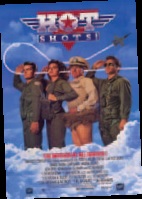
Hot Shots • 1991
Charlie Sheen stars in this Desert Storm era spoof a la The Naked Gun. The superb comedic timing he demonstrated a dozen years later on Two and a Half Men is on display in this popular farce.

Harry Potter and the Goblet of Fire • 2005
The fourth installment in the Harry Potter series, Goblet of Fire shows a more mature side of Harry and his Hogwarts friends. The film killed at the box office and featured teenagers Robert Pattinson and Katie Leung, who played Harry’s first love interest.
 Mad Hot Ballroom • 2005
Mad Hot Ballroom • 2005
The lone documentary on this list, Mad Hot Ballroom introduces us to the ballroom dancing program in the unlikeliest of places: the NYC public school system. Fifth graders tango and fox-trot their way into our hearts as they converge on the citywide finals.
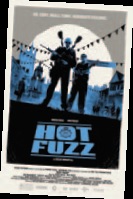
Hot Fuzz • 2007
Loveable goof balls Simon Pegg and Nick Frost star in an inspired send-up of the action film genre. Jim Broadbent, Timothy Dalton, Bill Nighy, Martin Freeman, Stephen Merchant, Cate Blanchett and Olivia Colman make up one of the all-time great supporting casts.
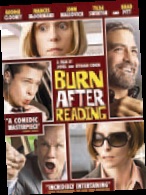 Burn After Reading • 2008
Burn After Reading • 2008
Brad Pitt and Frances McDormand play a pair of moronic gym employees who become hopelessly entangled in an intricate spy plot. George Clooney, John Malkovich, J.K. Simmons and Tilda Swinton co-starred in this screwball comedy penned by Joel and Ethan Coen.
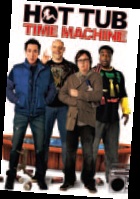 Hot Tub Time Machine • 2010
Hot Tub Time Machine • 2010
John Cusack, Craig Robinson, Clark Duke and Rob Corddry pass out after downing Chernobyl, a Russian energy drink, and wake up in 1986—with a stern warning from a hot tub repairman not to alter the future. A cast of likeable actors and a relentlessly ridiculous script make this movie difficult not to enjoy.
EPHOTO CREDITS
Ball of Fire • Samuel Goldwyn Productions
White Heat • Warner Bros. Pictures
The Flame and the Arrow • Warner Bros. Pictures
The Big Heat • Columbia Pictures
The Long Hot Summer • 20th Century Fox
Cat On a Hot Tin Roof • MGM
Some Like It Hot • The Mirisch Corp.
Fahrenheit 451 • Anglo Enterprises/Vineyard Film
In the Heat of the Night • The Mirisch Corp.
Body Heat • The Ladd Company/Warner Bros.
Chariots of Fire • Allied Stars/Goldcrest Films/The Ladd Company
Streets of Fire • Universal Pictures/RKO
St. Elmo’s Fire • Columbia Pictures
Mississippi Burning • Orion Pictures
Hot Shots • 20th Century Fox
Harry Potter and the Goblet of Fire • Warner Bros./Heyday Films
Mad Hot Ballroom • Nickelodeon Movies
Hot Fuzz • StudioCanal/Working Title/Big Talk
Burn After Reading • Focus Features
Hot Tub Time Machine • MGM/United Artists/New Crime Prod.
Cheese, wine and bread…this trio is life’s essence, a microcosm representative of its nourishment and joy.


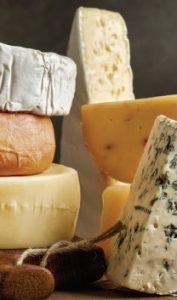 I’m not a highly curated, picture-perfect human. I’m a quirky, line-drawing, scribbles person. Also, I would operate at lightning speed if I could. Thankfully, I’ve found an antidote to this haste: fermentation. When things aren’t moving fast enough for me, fermentation reminds me of the value of waiting. Feeding my sourdough starter every morning, brewing a new batch of kombucha weekly…at the risk of sounding like an unhinged hipster, these are the routines that ground me. The practice of fermentation is as old as civilization itself, but the splendor of it found me in my early thirties while exploring cheese, wine, and bread in England, Italy and France.
I’m not a highly curated, picture-perfect human. I’m a quirky, line-drawing, scribbles person. Also, I would operate at lightning speed if I could. Thankfully, I’ve found an antidote to this haste: fermentation. When things aren’t moving fast enough for me, fermentation reminds me of the value of waiting. Feeding my sourdough starter every morning, brewing a new batch of kombucha weekly…at the risk of sounding like an unhinged hipster, these are the routines that ground me. The practice of fermentation is as old as civilization itself, but the splendor of it found me in my early thirties while exploring cheese, wine, and bread in England, Italy and France.
Fermentation is under our noses, but is only now entering most people’s awareness. It is the process by which a substance breaks down into a simpler substance, altering food with microbes rather than by cooking it with fire. If this produces the most essential, delicious foods on earth, what can the same process do for us, as humans? Our lives ferment; we all have awkward, smelly phases along with delicious, robust ones—mine certainly has.
Cheese, wine, and bread, I think you’ll agree, are three of life’s most delightful things. They can be found worldwide, each place informing them with its own unique history and stories that extend far beyond the delicious dance on the plate. These are three of my favorite recipes…
Stilton Scones with Cranberries
Scones are as English as Stilton. If you’re American, you probably pronounce it scoan, like “stone.” In England, it’s pronounced scon, like “con. ” However you say it, scones are an essential part of the afternoon-tea tradition (and also wonderful any time of day, in my opinion). Cranberries and blue cheese are a winning combination, and especially Christmasy. Another of my favorite variations is to swap out the cranberries for 2 tablespoons of coarsely chopped hazelnuts; if you do opt for the hazelnuts, try the scones with a smear of red onion and port marmalade or another fruity jam to bring the sweet kick.
” However you say it, scones are an essential part of the afternoon-tea tradition (and also wonderful any time of day, in my opinion). Cranberries and blue cheese are a winning combination, and especially Christmasy. Another of my favorite variations is to swap out the cranberries for 2 tablespoons of coarsely chopped hazelnuts; if you do opt for the hazelnuts, try the scones with a smear of red onion and port marmalade or another fruity jam to bring the sweet kick.
6 tablespoons (¾ stick/90 grams) unsalted butter, at room temperature, plus more for greasing
2½ cups (300 grams) all-purpose flour
¼ cup (50 grams) sugar
4 teaspoons (15 grams) baking powder
½ teaspoon fine sea salt
2⁄3 cup (160 milliliters) whole milk
1 large egg
2 tablespoons (about 20 grams) dried cranberries
6 ounces (180 grams) Stilton blue cheese, broken into large chunks (about 1 1⁄3 cups)
- Position a rack in the middle of the oven and preheat the oven to 400°F (200°C). Grease a sheet pan with a little butter.
- In a large bowl, whisk together the flour, sugar, baking powder, and salt until well combined and lump-free.
- Add the butter and use your fingertips to rub it into the dry ingredients until the butter is fully incorporated. The mixture should have the consistency of coarse cornmeal. Add the milk, egg, and cranberries and mix with a wooden spoon or silicone spatula until the dough comes together.Gently fold in the blue cheese chunks until just incorporated (you want those chunks to remain intact, not break down into smaller crumbs). The dough will be fairly wet.
- Using a tablespoon, take a heaping scoop of the dough (about 2 inches/5 centimeters in diameter, a bit smaller than a tennis ball but bigger than a golf ball) and place it on the prepared sheet pan. Repeat with the rest of the dough, spacing the scoops 1 inch (2.5 centimeters) apart. (The dough spreads as it bakes, so if your pan isn’t big enough to space out the scones, you’ll need to use two.)
- Bake for 5 minutes, then rotate the pan and bake for 5 minutes more. They’re done when they’re golden, with some browned bumps on the uneven surface. Bake for 2 to 6 minutes more, as needed.
- Remove the pan from the oven and transfer the scones to a wire rack. (Some of the melted cheese will have escaped and gotten crispy on your baking sheet—that’s the cook’s treat to nibble on!) Enjoy warm or at room temperature.
Spaghetti all’Ubriaco (Drunken Pasta)
When Italians discovered the joy of using their favorite beverage (wine) to cook their favorite food (pasta), variations of this plum-colored pasta dish became a standard meal. Spaghetti all’ubriaco—“drunken spaghetti”—isn’t as inebriated as it sounds: the heat burns off the alcohol in the wine. In cooking the pasta with the wine, however, the noodles are imbued with a subtle sweetness and depth of flavor. A medium-bodied dry red wine works well here, but honestly, I’ve used a wide variety of leftover reds. (The origin of this dish is considered to be Tuscany, so if you want to stay regional, you could uncork a Chianti or some other wine made primarily with sangiovese grapes, one of the most important grapes in Italy and grown abundantly in Tuscany.) Ideally, it would be a delicious red wine you would happily drink—and sometimes I do pour myself a glass and cook with the rest—but I also think the adage “waste not, want not” is perfectly applied here: If you have an opened bottle that’s past its prime for drinking, this is the perfect use for it. I make this version with nuts, cheese, herbs, garlic, and red pepper flakes. I love garlic, so I use a lot. If you don’t love a garlicky pasta, use fewer cloves. Ditto with the red pepper flakes. These simple ingredients are all you need to put together an addicting, lip-smacking plate of pasta. I find these deep-plum strands of spaghetti completely irresistible, as sexy as a satin sheet.
Coarse sea salt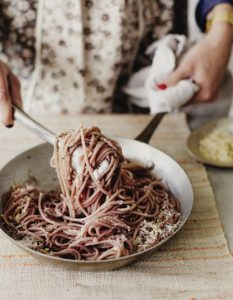
12 ounces (340 grams) dried spaghetti
¼ cup (60 milliliters) extra-virgin olive oil
4 small garlic cloves, thinly sliced
½ teaspoon red pepper flakes
1 cup (250 milliliters) red wine
½ cup (1.6 ounces/45 grams) freshly grated Pecorino Romano cheese, plus more for serving
¼ cup (45 grams) finely chopped nuts (I like pine nuts, walnuts, or almonds)
1⁄8 teaspoon freshly grated nutmeg
Fine sea salt and freshly ground black pepper
Sprigs of parsley, for garnish
- Fill a large pot three-quarters full of water and bring it to a boil over medium-high heat. Add a generous amount of coarse salt (the adage “It should taste like the sea” is a good gauge of how much). Cook the spaghetti for 2 minutes less than the instructions on the package for al dente. (You don’t want it to be completely cooked because it will continue cooking in the red wine later.)
- While the pasta is cooking, heat the olive oil in a large, high-sided pan over medium-low heat. Add the garlic and red pepper flakes and cook, stirring, for 1 minute, or until the garlic becomes fragrant. Pour the wine into the pan with the garlic and stir. Remove from the heat while the pasta finishes cooking.
- Drain the pasta, reserving 1 cup (about 250 milliliters) of the pasta water.
- Add the pasta to the pan with the wine and garlic over medium heat and stir. Cook, occasionally stirring gently, for 2 minutes, or until the pasta is al dente and has absorbed most of the wine, taking on a plum hue.
- Remove the pan from the heat and mix in the cheese and nuts. Stir in a tablespoon (or more) of the reserved pasta water; its starchiness mixes with the fat in the cheese to create a silky coating on the noodles. Finish with the nutmeg, season with salt and pepper, and stir to incorporate well. Taste and adjust the seasoning if you think the dish is asking for it.
- Serve garnished with parsley and topped with more cheese, and enjoy slurping down the drunken noodles.
Susie Q’s Sour Cream Challah
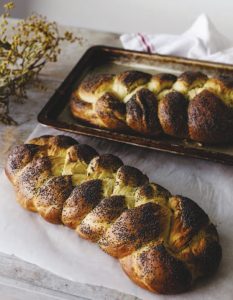 When I started writing Cheese, Wine and Bread, I asked my mom where she initially got her challah recipe, and learned that “mom’s loaf ” has evolved over time. This current iteration, which she’s made consistently for over a decade, was adapted from a dinner roll recipe from a 1990s issue of Cooking Light.
When I started writing Cheese, Wine and Bread, I asked my mom where she initially got her challah recipe, and learned that “mom’s loaf ” has evolved over time. This current iteration, which she’s made consistently for over a decade, was adapted from a dinner roll recipe from a 1990s issue of Cooking Light.
2 (¼-ounce/7-gram) packets active dry yeast (4½ teaspoons)
½ cup (125 milliliters) warm water (around 110°F/43°C)
½ cup (1 stick/115 grams) unsalted butter, at room temperature
½ cup (105 grams) sugar
1 cup (240 grams) sour cream
2 large eggs, whisked
5 cups (600 grams) unbleached all-purpose flour, plus more for dusting
1 teaspoon fine sea salt
1 tablespoon canola oil
1 egg white, beaten, for the egg wash
Poppy seeds, for garnish (optional)
- Combine the yeast and warm water in a large bowl. Let stand for 5 minutes.
- Cream the softened butter and sugar in a medium bowl using a whisk until smooth. Gradually stir in the sour cream until combined. Set aside.
- Add the eggs to the yeast mixture and mix well. Add the sour cream mixture and stir until smooth. Add 1 cup (120 grams) of the flour and the salt. Gradually mix in the remaining 4 cups (480 grams) flour until you have a shaggy dough.
- Sprinkle a work surface with flour. Tip the shaggy dough out onto the surface and sprinkle with a couple more pinches of flour.
Knead the dough with the palm of your hand (avoid poking it with your fingertips), adding flour as needed to prevent it from sticking to the work surface and your hands, until the dough is smooth, not sticky, and gently springs back when pressed with a fingertip (also called the “poke test”), about 5 minutes. (Another way to check that the dough has been kneaded long enough is by performing the “windowpane test”: Cut off a chunk of the dough—around 50 grams—and stretch it gently between your fingers into a thin sheet. If it breaks too easily, it needs more kneading, but if you can stretch the dough thin enough to see your fingers through it when it’s held up to the light, it’s good to go.)
- Pour the canola oil into a large bowl, then place the dough in the bowl and rotate to coat it with oil. Cover the bowl with a clean dish towel and place in a warm (75 to 80°F /24 to 27°C), draft-free area for about 90 minutes, until the dough has doubled in volume.
- Remove the dish towel and punch down the dough. Turn the dough out onto your work surface and divide it into two equal portions. Cut each portion into thirds so you have 6 portions. Roll each of these portions into a rope on a clean workspace (or just in the air, rolling the dough between your palms) about 15 inches (38 centimeters) long. Working with three ropes at a time, braid the ropes, pinching the ends to make sure they don’t unravel during the second rise, to form two loaves.
- Line two sheet pans with parchment paper or a silicone baking mat. Place each shaped braid on its own pan. Cover each with a clean dish towel and let rise in a warm, draft-free area for 30 to 45 minutes, until they bulk up in size a bit (but are not doubled).
- Near the end of this proof, arrange two racks in the oven—one on the bottom notch and the other second from the top—and preheat the oven to 375° F (190°C).
- Prepare an egg wash by whisking the egg white and 1 tablespoon of water in a small bowl until frothy. Uncover the dough and use a pastry brush to brush the loaves with the egg wash. Sprinkle with the poppy seeds, if using.
- Bake for 35 to 40 minutes, until the loaves are a dark golden brown and sound hollow when you knock on the underside. Make sure to switch the sheet pans’ position on the oven racks and to rotate the loaves 180° degrees halfway through to ensure even baking.
- Transfer the loaves from the sheet pans to wire racks and let cool thoroughly. Then enjoy!
The draw of these foods is that they take time to be transformed almost magically by the microbes within, which is a comforting prospect, and a necessary antidote to our live-tweeting culture. For instance, when you post a photo on Instagram or Facebook, do you automatically refresh the page as the likes pop up? Imagine if you had to wait two weeks, or two months, before you could see the responses, but when you received them, those responses, although not instantaneous, were somehow able to endure, like a lingering hug or a letter that’s traversed an ocean to land in your mailbox. Rather than the quick high of a digital fist bump, you receive a warm embrace. To me, that’s akin to the satisfaction fermentation offers.
 If fermentation is the preservation of food, those same principles of change and transformation must apply to us. We bring a bit of our past selves with us, and a hope for the future. When a new obstacle, opportunity, or question arises—as one always does—all we need to do is take a deep breath and let things ferment. Don’t overthink it. Just let it ferment.
If fermentation is the preservation of food, those same principles of change and transformation must apply to us. We bring a bit of our past selves with us, and a hope for the future. When a new obstacle, opportunity, or question arises—as one always does—all we need to do is take a deep breath and let things ferment. Don’t overthink it. Just let it ferment.
Editor’s Note:
Katie Quinn’s new book Cheese, Wine, and Bread: Discovering the Magic of Fermentation in England, Italy, and France ($29.99) was published in April by William Morrow, an imprint of HarperCollins Publishers. In it, Quinn shares the stories and science behind cheese, wine, and bread, along with dozens of classic recipes. Part artisanal survey, part travelogue and part cookbook, it features more than 100 pieces of art, including watercolor illustrations and color photographs.

